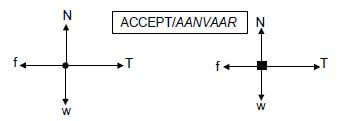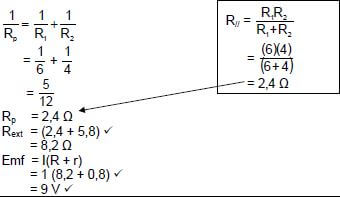Adele
PHYSICAL SCIENCES: CHEMISTRY PAPER 2 GRADE 12 MEMORANDUM - AMENDED SENIOR CERTIFICATE EXAMS PAST PAPERS AND MEMOS MAY/JUNE 2018
PHYSICAL SCIENCES: CHEMISTRY
PAPER 2
GRADE 12
AMENDED SENIOR CERTIFICATE EXAMS
PAST PAPERS AND MEMOS
MAY/JUNE 2018
MEMORANDUM
QUESTION 1
1.1 D ✓✓ (2)
1.2 A ✓✓ (2)
1.3 B ✓✓ (2)
1.4 B ✓✓ (2)
1.5 D ✓✓ (2)
1.6 C ✓✓ (2)
1.7 B ✓✓ (2)
1.8 D ✓✓ (2)
1.9 D ✓✓ (2)
1.10 C ✓✓ (2) [20]
QUESTION 2
2.1
2.1.1 A ✓ (1)
2.1.2 D ✓ (1)
2.1.3 B ✓ (1)
2.1.4 E ✓ (1)
2.1.5 B ✓ (1)
2.2
2.2.1 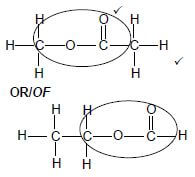
Marking criteria
|
Accept
- Any correct arrangement of correct number of atoms (2)
2.2.2 ANY ONE:
- Methyl ✓ethanoate ✓
OR/OF - Ethyl ✓methanoate ✓ (2)
2.3
2.3.1 A large molecule ✓composed of smaller monomer units covalently bonded to each other in a repeating pattern. ✓ (2)
2.3.2 Polyethene ✓
Accept:
- Polyethylene/polythene (1)
2.3.3 
Accept as reactant:
Accept as product:![]() (3)
(3)
2.4 Hydrolysis/Substitution ✓ (1)
Marking guidelines
|
2.5
- Use concentrated strong base/NaOH/KOH/LiOH OR ethanolic/alcoholic strong base/NaOH/KOH/LiOH. ✓/Use ethanol instead of water./No water.
- Heat strongly ✓
Accept: Increase temperature (2) [18]
QUESTION 3
3.1
- Structure:
The chain length/molecular size /molecular structure/molecular mass/ surface area increases. ✓ - Intermolecular forces:
Increase in strength of intermolecular forces/induced dipole /London/ dispersion /Van der Waals forces/momentary dipoles. ✓ - Energy:
More energy needed to overcome/break intermolecular forces. ✓
OR
Structure:
From 4 C atoms to 1 C atom/bottom to top the chain length/molecular size/molecular structure/molecular mass/surface area decreases. ✓ - Intermolecular forces:
Decrease in strength of intermolecular forces/ induced dipole forces/ London forces/dispersion forces. ✓
Energy:
Less energy needed to overcome/break intermolecular forces. ✓ (3)
3.2
- Alkanes have London/dispersion/induced dipole forces. ✓
- Alcohols have hydrogen bonding (in addition to London/dispersion/ induced dipole forces and dipole dipole forces). ✓
- Hydrogen bonding are stronger intermolecular forces than London/ dispersion/ induced dipole forces. ✓
OR/OF
More energy needed to overcome/break intermolecular forces in alcohols - Alcohols have higher boiling points than alkanes. ✓ (4)
3.3 Decrease ✓ (1)
3.4 Lower than✓ - 2-methylpropane/It is more branched/has a smaller surface area/has a shorter chain length (than butane/chain isomer) ✓
OR
Butane/chain isomer is less branched /has larger surface area/longer chain length (than 2-methylpropane). (2) [10]
QUESTION 4
4.1
4.1.1 Substitution/halogenation/bromonation✓ (1)
4.1.2 Elimination/dehydration ✓ (1)
4.1.3 Esterification/condensation ✓ (1)
4.1.4 Addition/hydrohalogenation/hydrobromonation ✓ (1)
4.2
4.2.1 Catalyst/dehydrating agent/speeds up reaction ✓ (1)
4.2.2 Propyl ✓ ethanoate ✓/Propieletanoaat (2)
4.2.3  (2)
(2)
Marking criteria:
| |
IF:
|
4.3  (5)
(5)
Notes:
|
[14]
QUESTION 5
5.1 ONLY ANY ONE OF:
- Change in concentration of products/reactants ✓ per (unit) time. ✓
- Rate of change in concentration. ✓✓
- Change in amount/number of moles/volume/mass ✓ of products or reactants per (unit) time. ✓
- Amount/number of moles/volume/mass (of products) formed/(reactants) used✓ per (unit) time.✓ (2)
5.2
5.2.1 Surface area/State of division ✓ (1)
5.2.2 ANY ONE:
- Amount/mass of magnesium ✓
- Concentration of HCℓ/acid
- (Initial) temperature (1)
5.3
5.3.1 (5)
Marking criteria:
| |
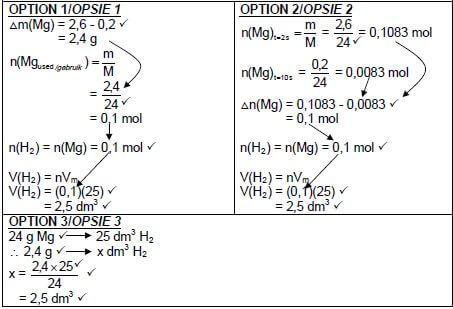 |
5.3.2
Marking criteria
|
ave rate / tempo = ∆n ✓
∆t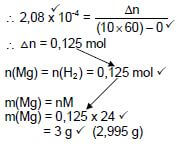 (5)
(5)
5.4
- Larger surface area/state of division. ✓
- More particles (per volume) with correct orientation ✓
OR - More contact points./Meer kontakpunte.
- More effective collisions per (unit) time./Frequency of effective collisions increases./More particles collide with sufficient kinetic energy & correct orientation per (unit) time.✓✓ (3) [17]
QUESTION 6
6.1 The stage in a chemical reaction when the rate of forward reaction equals the rate of reverse reaction./Both forward and reverse reactions take place at same rate. ✓✓
OR
The stage in a chemical reaction when the concentrations of reactants and products remain constant. ✓✓ (2)
6.2
6.2.1 2 ✓ (1)
6.2.2 1 ✓ (1)
6.2.3 3 ✓ (1)
6.3 POSITIVE MARKING FROM QUESTION 6.2.
Marking criteria:
|
OPTION 1
|
OPTION 2
Kc = [C]3 = 6,75 ✔ (7)
|
USING CONCENTRATION
Kc = [C]3 = 6,75 ✔ (7)
|
6.4 Endothermic ✔
- (An increase in temperature) favours the reverse reaction. ✔
- An increase in temperature favours an endothermic reaction. ✔ (3) [15]
QUESTION 7
7.1 Titration/Volumetric analysis ✓ (1)
7.2 To measure the (exact) volume of acid needed to reach endpoint/to neutralise the base. ✓ (1)
7.3 Acids produce hydrogen ions (H+)/hydronium ions (H3O+) in solution/when dissolved in water. ✓✓
IF:
- Acids produce hydrogen ions (H+)/hydronium ions (H3O+). ✓ (2)
7.4 H2SO4 ionises completely.✓ (1)
7.5 Blue to yellow✓ (1)
7.6 (4)
Marking guidelines:
| |
OPTION 1 | OPTION 2 |
7.7 POSITIVE MARKING FROM QUESTION 7.6.
Marking guidelines:
| |
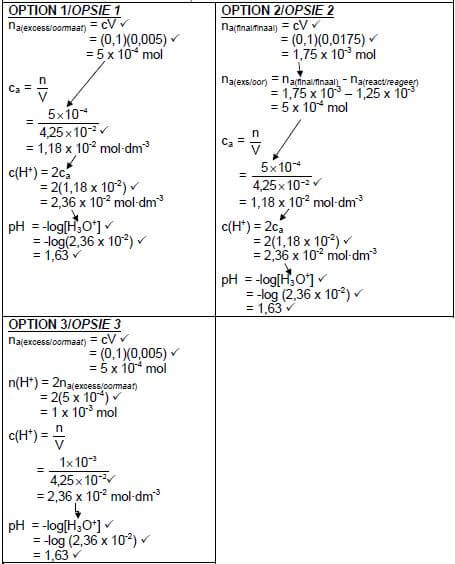 (7) (7) |
[17]
QUESTION 8
8.1
8.1.1 Galvanic (cell)/Voltaic (cell) ✓ (1)
8.1.2 Indicates phase boundary./Interphase /phase separator✓ (1)
8.1.3 Fe2+ → Fe3+ + e- ✓✓ (2)
Notes
|
8.1.4 (5)
OPTION 1 | Notes
|
OPTION 2 | |
8.2
8.2.1 Pt ✓ (1)
8.2.2 Iron(III) (ions)Ferric ions✓ (1)
8.2.3 2Fe3+ + Cu ✓→ 2Fe2+ + Cu2+ ✓ Bal. ✓ (3)
Notes
|
[14]
QUESTION 9
9.1
9.1.1 Electrolyte ✓ (1)
9.1.2 Conduct electricity/Carry charges ✓ (1)
9.2 Cu(NO3)2 ✓ (1)
9.3 Iron rod✓ - Reduction takes place. ✓ (2)
9.4 Cu → Cu2+ + 2e-✓✓ (2)
Notes
|
9.5
9.5.1 Copper(II) (ions)/Cu2+ ✓and silver (ions)/Ag+ ✓
Accept
- Cu (ions) and Ag (ions) (Ions are stated in the question.) (2)
9.5.2 Ag+/silver(I) ions is a stronger oxidising agent ✓ than Cu2+/Copper(II) ions and will be reduced (more readily) ✓ to form silver/Ag on the iron rod. (2 ) [11]
QUESTION 10
10.1
10.1.1 (Catalytic) oxidation (of ammonia)✓ (1)
10.1.2 Neutralisation/acid-base reaction ✓ (1)
10.2
10.2.1 Nitrogen/N2✓ (1)
10.2.2 NO2/nitrogen dioxide✓ (1)
10.2.3 Nitric acid/HNO3✓ (1)
10.3
10.3.1 2NH3 + H2SO4 ✓ → (NH4)2SO4 ✓ Bal. ✓ (3)
Notes:
|
10.3.2 4NH3 + 5O2 ✓ → 4NO + 6H2O ✓ Bal. ✓ (3)
Notes :
|
10.4 % N = 28 × 100 ✓
80 ✓
= 35% ✓ (3) [14]
TOTAL: 150
PHYSICAL SCIENCES: PHYSICS PAPER 1 GRADE 12 MEMORANDUM - AMENDED SENIOR CERTIFICATE EXAMS PAST PAPERS AND MEMOS MAY/JUNE 2018
PHYSICAL SCIENCES: PHYSICS
PAPER 1
GRADE 12
AMENDED SENIOR CERTIFICATE EXAMS
PAST PAPERS AND MEMOS
MAY/JUNE 2018
MEMORANDUM
QUESTION 1
1.1 C✔✔ (2)
1.2 A✔✔ (2)
1.3 D✔✔ (2)
1.4 A✔✔ (2)
1.5 C✔✔ (2)
1.6 A✔✔ (2)
1.7 B✔✔ (2)
1.8 B✔✔ (2)
1.9 D✔✔ (2)
1.10 A✔✔ (2) [20]
QUESTION 2
2.1 The rate of change of velocity. ✔✔
Accept
Change in velocity per unit time (2)
NOTE: |
2.2
OPTION 1 |
OPTION 2 |
OPTION 3 |
2.3
POSITIVE MARKING FROM 2.2 |
OPTION 2 Wnet = ∆EK✔ |
OPTION 3 |
2.4 (4)
Notes
(4) | |||||||||||||||
2.5
POSITIVE MARKING FROM 2.2 AND 2.3 | |
For P | OR For P |
[15]
QUESTION 3
3.1
- Motion under the influence of gravity/weight/gravitational force only. ✔✔
OR - Motion in which the only force considered is gravitational. ✔✔ (2)
NOTE: |
3.2
OPTION 1 DOWNWARDS AS POSITIVE Height = 2Δy |
OPTION 2 | |
UPWARD POSITIVE
= - 4,9 m Height = (2)(4,9) | DOWNWARD POSITIVE |
OPTION 3 | |
UPWARD POSITIVE Height = 2Δy | DOWNWARD POSITIVE vf2 = vi2 + 2aΔy✔ Height = 2Δy |
OPTION 4 | |
UPWARD POSITIVE | DOWNWARD POSITIVE |
E(mech)Top = E(mech atB) ✔ | |
OPTION 5 | |
UPWARD POSITIVE | DOWNWARD POSITIVE |
Wnet = ∆K✔ | |
OPTION 6 | |
UPWARD POSITIVE | DOWNWARD POSITIVE |
Wnc = ∆K + ∆U✔ | |
3.3 (3)
OPTION 1 DOWNWARDS AS POSITIVE OR Magnitude = 13,86m·s-1✔ |
OPTION 2 |
3.4
OPTION 1 |
UPWARDS AS POSITIVE Fnet = 47,32 N✔ |
OPTION 2 |
OPTION 3 |
[14]
QUESTION 4
4.1 (4)
E(mech top) = E(mech bottom) |
4.2 In a/an closed/isolated✓ system, the total✓ linear momentum is conserved. (2)
4.3 (4)
POSITIVE MARKING FROM 4.1 |
4.4 POSITIVE MARKING FROM 4.3
OPTION 1
Δx = vΔt✔
= (2,68)(3) ✔
= 8,04 m ✔
OPTION 2
= 8,04 m
OPTION 3
Δx = viΔt + ½ aΔt2✔
= (2,68)(3) + ½ (0)(3)2✔
= 8,04 m ✔ (Range 8,04 – 8,05) (2) [13]
QUESTION 5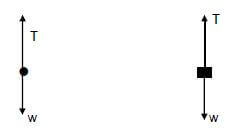 (2)
(2)
Accepted labels | |
w | Fg/Fw/weight/mg/gravitational force/N/19,6 N |
T | Tension/FT/ FA/ |
Notes
|
5.2 Tension✔
Accept Fapplied (1)
5.3
W = F∆xcosθ OR Ww = -ΔEp ✔ |
5.4
- The work done on an object by a net force is equal to the change in the object’s kinetic energy. ✔✔
OR - The net work done on an object is equal to the change in the object’s kinetic energy✔✔ (2)
NOTE: |
5.5 (5)
POSITIVE MARKING FROM 5.3 |
POSITIVE MARKING FROM 5.2 |
[13]
QUESTION 6
6.1 It is the (apparent) change in frequency (or pitch) of the sound (detected by a listener) ✔because the sound source and the listener have different velocities relative to the medium of sound propagation. ✔
OR
An (apparent) change in(observed/detected) frequency (pitch),(wavelength) ✔ as a result of the relative motion between a source and an observer ✔ (listener). (2)
NOTE: |
6.2
OPTION 1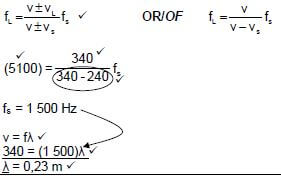 (7)
(7)
OPTION 2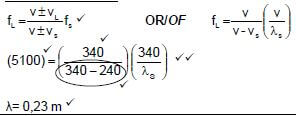 (7)
(7)
6.3 Greater than ✔(1) [10]
QUESTION 7
7.1
- The two forces must be equal in magnitude ✔ but in opposite directions ✔
OR - The force experienced by Q due to P, must be equal in magnitude ✔but opposite in direction to the force experienced by Q due to V.✔ (2)
7.2
- The magnitude of the electrostatic force exerted by one point charge on another point charge is directly proportional to the product of the (magnitudes of the) charges✔ and inversely proportional to the square of the distance (r) between them. ✔
OR - The force of attraction or repulsion between two point charges is directly proportional to the product of the charges ✔ and inversely proportional to the square of the distance between them. ✔ (2)
NOTE: |
NOTE: |
7.3 (5)
| OPTION 1 F = kQ1Q2 r2 FPQ = (9 × 109)(Q)(5×10-6) = 63 × 103Q 6,708(1 - x) = 7,937x x |
| OPTION 2 E = kQp |
QUESTION 8
8.1  (2)
(2)
Criteria for sketch | Marks |
Lines are directed away from the charge | ✔ |
Lines are radial, start on sphere and do not cross. | ✔ |
8.2 (7)
Q = ne✔ |
[9]
QUESTION 9
9.1.1 The potential difference across a conductor is directly proportional to the current in the conductor at constant temperature.
OR
The ratio of potential difference across a conductor to the current in the conductor is constant, provided the temperature remains constant. (2)
NOTE: |
9.1.2 (3)
V1 = IR ✔ |
9.1.3 (2)
POSITIVE MARKING FROM 9.1.2 | OR 6 (I) = 0,6 ✔ | OR |
9.1.4 (2)
POSITIVE MARKING FROM 9.1.3 |
9.1.5 (3)
POSITIVE MARKING FROM 9.1.4 AND 9.1.2 |
OPTION 2
|
9.1.6 (3)
POSITIVE MARKING FROM 9.1.5 AND 9.1.3 | ||
W = V I ∆t ✔ | W = I2R ∆t ✔ | W = V2Δt ✔ |
9.2.1 (2)
R = V |
9.2.2 Increases ✔
- Total resistance decreases, ✔ current/power increases✔, motor turns faster (3) [20]
QUESTION 10
10.1
10.1.1 Split ring / commutator ✔ (1)
10.1.2 Anticlockwise ✔✔(2)
10.1.3 Electrical energy ✔to mechanical(kinetic) energy ✔ (2)
10.2
10.2.1 DC generator: split ring/commutator and AC generator has slip rings✔
OR
AC generator: slip ring and DC generator has split rings✔ (1)
10.2.2 (3)
Vrms = Vmax |
10.2.3
OPTION 2 |
POSITIVE MARKING FROM 10.2.2 |
OPTION 2
Paverage = V2rms
R
= 226,272✔
35
= 1462,80 W
Paverage = VrmsIrms✔ | Paverage = I2rmsR✔ |
POSITIVE MARKING FROM 10.2.2 |
[13]
QUESTION 11
11.1 Work function (of a metal) is the minimum energy needed to eject an electron from the metal/surface (2)
NOTE: |
11.2 (Maximum) kinetic energy of the ejected electrons✔ (1)
11.3 Wavelength/Frequency (of light) ✔ (1)
11.4 Silver✔
- According to Photoelectric equation, hf = Wo + ½ mv2
(For a given constant frequency), as the work function increases the kinetic energy decreases. ✔ Silver has the smallest kinetic energy✔ and hence the highest work function. (3)
1.1.5
hf = Wo + ½mv2max ✔ |
11.6 REMAINS THE SAME✔
- Increasing intensity increases number of photons(per unit time) but frequency stays constant✔ the energy of the photon is the same ✔therefore the kinetic energy does not change. (3) [14]
TOTAL: 150
PHYSICAL SCIENCES: PHYSICS PAPER 1 GRADE 12 QUESTIONS - AMENDED SENIOR CERTIFICATE EXAMS PAST PAPERS AND MEMOS MAY/JUNE 2018
PHYSICAL SCIENCES: PHYSICS
PAPER 1
GRADE 12
AMENDED SENIOR CERTIFICATE EXAMS
PAST PAPERS AND MEMOS
MAY/JUNE 2018
INSTRUCTIONS AND INFORMATION
- Write your examination number and centre number in the appropriate spaces on the ANSWER BOOK.
- This question paper consists of 11 questions. Answer ALL the questions in the ANSWER BOOK.
- Start EACH question on a NEW page in the ANSWER BOOK.
- Number the answers correctly according to the numbering system used in this question paper.
- Leave ONE line between two subquestions, for example between QUESTION 2.1 and QUESTION 2.2.
- You may use a non-programmable calculator.
- You may use appropriate mathematical instruments.
- You are advised to use the attached DATA SHEETS.
- Show ALL formulae and substitutions in ALL calculations.
- Round off your FINAL numerical answers to a minimum of TWO decimal places.
- Give brief motivations, discussions, et cetera where required.
- Write neatly and legibly.
QUESTIONS
QUESTION 1: MULTIPLE-CHOICE QUESTIONS
Various options are provided as possible answers to the following questions. Choose the answer and write down only the letter (A-D) next to the question numbers (1.1 to 1.10) in the ANSWER BOOK, e.g. 1.11 D.
1.1 The net (resultant) force acting on an object is equal to the ... of the object in the direction of the net force.
- change in momentum
- change in kinetic energy
- rate of change of momentum
- rate of change of kinetic energy (2)
1.2 A physical quantity that is described as a measure of the resistance of a body to a change in motion is called …
- inertia.
- force.
- acceleration.
- weight. (2)
1.3 The diagram below shows a section of the path of a stone projected vertically upwards.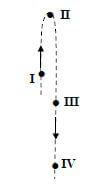
At which ONE of the positions indicated on the diagram will the magnitude of the momentum of the stone be the GREATEST? Ignore air resistance.
- I
- II
- III
- IV (2)
1.4 Two cars, P and Q, moving in a straight line, have the same momentum. The kinetic energy of Q is greater than the kinetic energy of P.
Which ONE of the following statements regarding the cars is CORRECT?
- Q has a smaller mass than P.
- Q has the same mass as P.
- Q is moving slower than P.
- Q is moving at the same speed as P. (2)
1.5 The net work done on an object to increase its speed from rest to v is W.
How much net work must be done on the same object to increase its speed from v to 2v?
- W
- 2W
- 3W
- 4W (2)
1.6 Which ONE of the following is NOT an application of the Doppler effect?
- A light meter
- A blood flow meter
- Detecting the heartbeat of a foetus using ultrasound
- Measuring the speed of an approaching car using radar (2)
1.7 Two small identical metal spheres, on insulated stands, carry charges -q and +3q respectively.
When the centres of the spheres are a distance d apart, the spheres exert an electrostatic force of magnitude F on each other.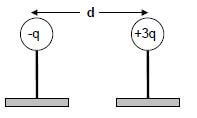
The spheres are now made to touch and are brought back to the same positions as before.
The magnitude of the electrostatic force which the spheres now exert on each other, in terms of F, is:
- 4 F
3 - 1 F
3 - 1 F
2 - 3F (2)
1.8 In the circuit below the battery has an emf (ε) and internal resistance r. With switch S open, readings are registered on the ammeter and voltmeter.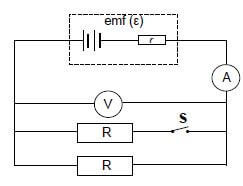
Switch S is now closed. How do the readings on the ammeter and voltmeter change? (2)
| AMMETER READING | VOLTMETER READING | |
| A | Increases | Remains the same |
| B | Increases | Decreases |
| C | Decreases | Remains the same |
| D | Decreases | Decreases |
1.9 A learner lists the following as factors that affect the magnitude of the current induced in an AC generator:
(i) The number of turns (windings) of the coil
(ii) The strength of the magnetic field
(iii) The speed of rotation of the coil
Which ONE of the combinations below is CORRECT?
- (i) and (ii) only
- (i) and (iii) only
- (ii) and (iii) only
- (i), (ii) and (iii) (2)
1.10 The graph below is obtained from an experiment on the photoelectric effect.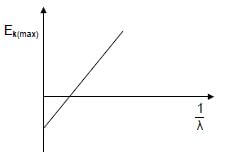
Which ONE of the following represents the gradient of the graph?
- hc
- h
- Ek(max)
λ - W0 (2) [20]
QUESTION 2 (Start on a new page.)
Block P, of unknown mass, is placed on a rough horizontal surface. It is connected to a second block of mass 3 kg, by a light inextensible string passing over a light, frictionless pulley, as shown below.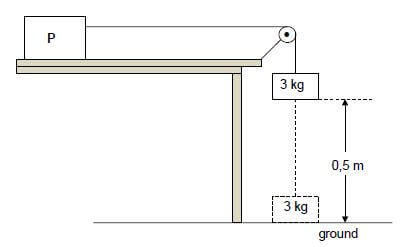
Initially the system of masses is held stationary with the 3 kg block, 0,5 m above the ground. When the system is released the 3 kg block moves vertically downwards and strikes the ground after 3 s. Ignore the effects of air resistance.
2.1 Define the term acceleration in words. (2)
Calculate the magnitude of the:
2.2 Acceleration of the 3 kg block using equations of motion (3)
2.3 Tension in the string (3)
The magnitude of the kinetic frictional force experienced by block P is 27 N.
2.4 Draw a labelled free-body diagram for block P. (4)
2.5 Calculate the mass of block P. (3) [15]
QUESTION 3 (Start on a new page.)
In the diagram below, point A is at the top of a building. Point B is exactly halfway between the point A and the ground. Ignore air resistance.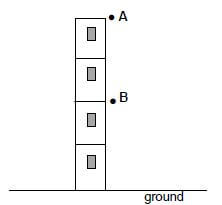
3.1 Define the term free fall. (2)
A ball of mass 0,4 kg is dropped from point A. It passes point B after 1 s.
3.2 Calculate the height of point A above the ground. (3)
When the ball strikes the ground it is in contact with the ground for 0,2 s and then bounces vertically upwards, reaching a maximum height at point B.
3.3 Calculate the magnitude of the velocity of the ball when it strikes the ground. (3)
3.4 Calculate the magnitude of the average net force exerted on the ball while it is in contact with the ground. (6) [14]
QUESTION 4 (Start on a new page.)
A trolley of mass 1,5 kg is held stationary at point A at the top of a frictionless track. When the 1,5 kg trolley is released, it moves down the track. It passes point P at the bottom of the incline and collides with a stationary 2 kg trolley at point B. Refer to the diagram below. Ignore air resistance and rotational effects.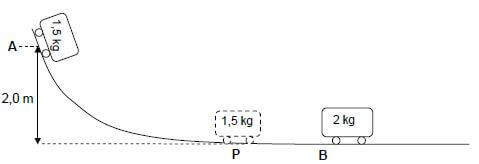
4.1 Use the principle of conservation of mechanical energy to calculate the speed of the 1,5 kg trolley at point P. (4)
When the two trolleys collide, they stick together and continue moving with constant velocity.
4.2 The principle of conservation of linear momentum is given by the incomplete statement below.
In a/an … system, the … linear momentum is conserved.
Rewrite the complete statement and fill in the missing words or phrases. (2)
4.3 Calculate the speed of the combined trolleys immediately after the collision. (4)
4.4 Calculate the distance travelled by the combined trolleys in 3 s after the collision. (3) [13]
QUESTION 5 (Start on a new page.)
A load of mass 75 kg is initially at rest on the ground. It is then pulled vertically upwards at a constant acceleration of 0,65 m⋅s-2 by means of a light inextensible rope.
Refer to the diagram below. Ignore air resistance, rotational effects and the mass of the rope.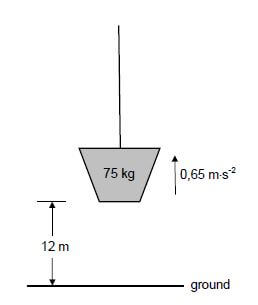
5.1Draw a labelled free-body diagram for the load while it moves upward. (2)
5.2 Name the non-conservative force acting on the load. (1)
5.3 Calculate the work done on the load by the gravitational force when the load has reached a height of 12 m. (3)
5.4 State the work-energy theorem in words. (2)
5.5 Use the work-energy theorem to calculate the speed of the load when it is at a height of 12 m. (5) [13]
QUESTION 6 (Start on a new page.)
A sound source, moving at a constant speed of 240 m∙s-1 towards a detector, emits sound at a constant frequency. The detector records a frequency of 5 100 Hz.
Take the speed of sound in air as 340 m∙s-1.
6.1 State the Doppler effect. (2)
6.2 Calculate the wavelength of the sound emitted by the source. (7)
Some of the sound waves are reflected from the detector towards the approaching source.
6.3 Will the frequency of the reflected sound wave detected by the sound sourcebe EQUAL TO, GREATER THAN or SMALLER THAN 5 100 Hz? (1) [10]
QUESTION 7 (Start on a new page.)
A particle, P, with a charge of + 5 x 10-6 C, is located 1,0 m along a straight line from particle V, with a charge of +7 x 10-6 C. Refer to the diagram below.
A third charged particle, Q, at a point x metres away from P, as shown above, experiences a net electrostatic force of zero newton.
7.1 How do the electrostatic forces experienced by Q due to the charges on P and V respectively, compare with each other? (2)
7.2 State Coulomb's law in words. (2)
7.3 Calculate the distance x. (5) [9]
QUESTION 8 (Start on a new page.)
A small metal sphere Y carries a charge of + 6 x 10-6 C.
8.1 Draw the electric field pattern associated with sphere Y. (2)
8.2 If 8 x 1013 electrons are now transferred to sphere Y, calculate the electric field at a point 0,5 m from the sphere. (7) [9]
QUESTION 9 (Start on a new page.)
9.1 In the circuit diagram below the battery has an unknown emf (ε) and an internal resistance (r) of 0,8 Ω.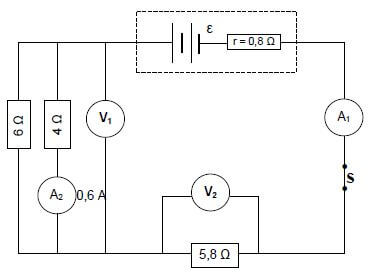
9.1.1 State Ohm's law in words. (2)
The reading on ammeter A2 is 0,6 A when switch S is closed.
Calculate the:
9.1.2 Reading on voltmeter V1 (3)
9.1.3 Current through the 6 Ω resistor (2)
9.1.4 Reading on voltmeter V2 (2)
9.1.5 Emf (ε) of the battery (3)
9.1.6 Energy dissipated as heat inside the battery if the current flows in the circuit for 15 s (3)
9.2 A simplified circuit diagram for the windscreen wiper of a car consists of a variable resistor and a wiper motor connected to a 12 volt battery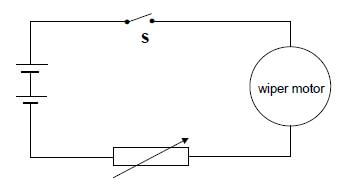
When switch S is closed, the potential difference across the variable resistor is 2,8 V and the current passing through it is 0,7 A.
9.2.1 Calculate the resistance of the variable resistor. (2)
The resistance of the variable resistor is now decreased.
9.2.2 State whether the speed at which the wiper turns will INCREASE, DECREASE or REMAIN THE SAME.
Give a reason for the answer. (3) [20]
QUESTION 10 (Start on a new page.)
10.1 The diagram below is a simplified representation of a DC motor. The current in the coil is in the direction XY.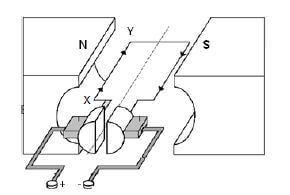
10.1.1 Name the component that ensures that the coil rotates continuously in ONE DIRECTION. (1)
10.1.2 In which direction will the coil rotate? Write down only CLOCKWISE or ANTICLOCKWISE. (2)
10.1.3Write down the energy conversion which takes place while the motor is working. (2)
10.2An AC generator, producing a maximum voltage of 320 V, is connected to a heater of resistance 35 Ω.
10.2.1 Write down the structural difference between an AC generator and a DC generator. (1)
Calculate the:
10.2.2 Root mean square (rms) value of the voltage (3)
10.2.3 Root mean square (rms) value of the current in the heater (4) [13]
QUESTION 11 (Start on a new page.)
A group of students investigates the relationship between the work function of different metals and the maximum kinetic energy of the ejected electrons when the metals are irradiated with light of suitable frequency.
11.1 Define the term work function. (2)
During the investigation ultraviolet rays of wavelength 2 x 10-8 m are allowed to fall on different metal plates. The corresponding maximum kinetic energies of ejected electrons are measured.
The data obtained is displayed in the table below.
| METAL PLATE USED | MAXIMUM KINETIC ENERGY (Ek(max)) (x 10-18 J) |
| Lead | 9,28 |
| Potassium | 9,58 |
| Silver | 9,19 |
11.2 Write down the dependent variable for this investigation. (1)
11.3Write down ONE control variable for this investigation. (1)
11.4Using the information in the table, and without any calculation, identify the metal with the largest work function.
Explain the answer. (3)
11.5 Use information in the table to calculate the work function of potassium. (4)
11.6 State how an increase in the intensity of the ultraviolet light affects the maximum kinetic energy of the photoelectrons. Choose from: INCREASES, DECREASES, REMAINS THE SAME.Explain the answer. (3) [14]
TOTAL: 150
DATA FOR PHYSICAL SCIENCES GRADE 12
PAPER 1 (PHYSICS)
TABLE 1: PHYSICAL CONSTANTS
NAME | SYMBOL | VALUE |
Acceleration due to gravity | g | 9,8 m•s-2 |
Universal gravitational constant | G | 6,67 × 10-11 N•m2•kg-2 |
Speed of light in a vacuum | c | 3,0 × 108 m•s-1 |
Planck's constant | h | 6,63 × 10-34 J•s |
Coulomb's constant | k | 9,0 × 109 N•m2•C-2 |
Charge on electron | e | -1,6 × 10-19 C |
Electron mass | me | 9,11 × 10-31 kg |
Mass of earth | M | 5,98 × 1024 kg |
Radius of earth | RE | 6,38 × 103 km |
TABLE 2: FORMULAE
MOTION
| vf = vi + aΔt | Δx = ViΔt + ½aΔt2 or Δy = ViΔt2 + ½aΔt2 |
Vf2 = Vi2 + 2aΔx or Vf2 = vi2 + 2aΔy | Δx = [Vi + Vf]Δt or Δy = [Vi + Vf]Δt |
FORCE
Fnet = ma | p= mv |
fsmax = µsN | fk = µkN |
FnetΔt = Δp | w =mg |
F = Gm1m2 | g = G M |
WORK, ENERGY AND POWER
W =FΔxcosθ | U= mgh or EP = mgh |
K = ½mv2 or Ek = ½mv2 | Wnet = ΔK or Wnet = ΔEk ΔK = Kf −Ki or ΔEk =Ekf − Eki |
Wnc= ΔK + ΔU or Wnc= ΔEk + ΔEp | P = W Δt |
Pav = Fv |
WAVES, SOUND AND LIGHT
v = f λ | T =1/f |
fl = v ± vl fs fl = v ± vl fb | E = hf or E = h c |
E = W0 + Ek where | |
ELECTROSTATICS
| F = kQ1Q2 r2 | E = KQ |
E = V | E = F |
V = W | n = Q |
ELECTRIC CIRCUITS
R = V | emf (ε) = I(R + r) |
RS = R1 + R2 + ....... | q = I Δt |
W = Vq | P= W |
ALTERNATING CURRENT
I rms = Imax | Paverage = VrmsIrms |
HISTORY PAPER 1 GRADE 12 ADDENDUM - AMENDED SENIOR CERTIFICATE EXAMS PAST PAPERS AND MEMOS MAY/JUNE 2018
HISTORY
PAPER 1
GRADE 12
AMENDED SENIOR CERTIFICATE EXAMS
PAST PAPERS AND MEMOS
MAY/JUNE 2018
ADDENDUM
QUESTION 1: WHY DID CUBA BECOME THE FOCAL POINT OF THE COLD WAR BETWEEN THE UNITED STATES OF AMERICA AND THE SOVIET UNION IN THE 1960s?
SOURCE 1A
This source explains how President Eisenhower and President Kennedy of the United States of America responded to Cuba becoming a communist country in the 1960s.
President Eisenhower had early on suspected that Castro would take Cuba down the communist path, so in March 1960 he had secretly authorised the use of thirteen million dollars to train Cuban exiles, the people who had fled Cuba, to carry out an invasion of Cuba and oust (remove) Castro. [From http://ic.galegroup.com/ic/uhic/ReferenceDetailspage/ReferenceDetailsWindow? Accessed on 18 November 2017.] |
SOURCE 1B
The source below is an extract from a letter that was written by the Soviet Premier, Nikita Khrushchev, to the US President, JF Kennedy, on 18 April 1961. It called for an end of the United States of America's aggression against Cuba.
Mr President, I send you this message in an hour of alarm, fraught (troubled) with danger for the peace of the whole world. Armed aggression has begun against Cuba. It is a secret to no one that the armed bands invading this country were trained, equipped and armed in the United States of America. The planes which are bombing Cuban cities belong to the United States of America; the bombs they are dropping are being supplied by the American government. [From The Kennedy-Khrushchev Letters by T Fensch, ed.] |
SOURCE 1C
This source explains how President Khrushchev assisted Cuba.
Although he had defeated the Cuban exiles' who invaded at the Bay of Pigs, Castro was afraid the United States still wanted to invade Cuba in order to get rid of him, change the government, and destroy Cuba's communist revolution. So he asked his friend, Soviet Chairman Khrushchev, for more help. [From On the Brink: from the Bay of Pigs to the Cuban Missile Crisis by M Mooney] |
SOURCE 1D
The map below illustrates a naval blockade that the United States of America imposed on Soviet ships that intended entering Cuba in October 1962. 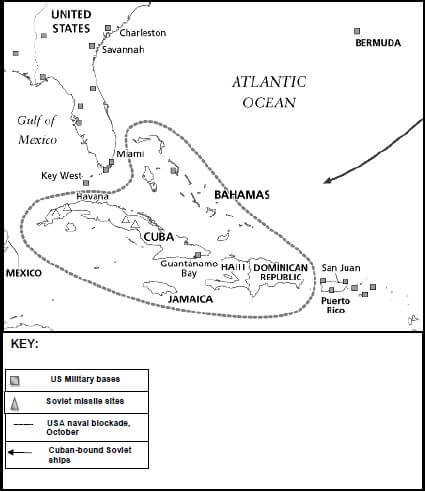
[From http://libguides.monroe2boces.org. Accessed on 9 February 2018.]
QUESTION 2: HOW DID THE INTERVENTION BY FOREIGN POWERS INTENSIFY COLD WAR TENSIONS IN ANGOLA BETWEEN 1974 AND 1976?
SOURCE 2A
This source explains how the MPLA, FNLA and UNITA fought over control of Angola after it attained independence in 1975.
Three main military movements had been fighting for Angolan independence since the 1960s. The Popular Movement for the Liberation of Angola (MPLA) was a Marxist organisation centred in the capital, Luanda, and led by Agostinho Neto. The National Front for the Liberation of Angola (FNLA), led by Holden Roberto, was based in the north of the country and had strong ties to the US ally (friend), Mobutu Sese Seko, in neighbouring Zaire. The National Union for the Total Independence of Angola (UNITA), an offshoot of the FNLA, was led by Jonas Savimbi and supported by the country's largest ethnic group, the Ovimbundu. [From http://history.state.gov/milestones/1969-1976/angola. Accessed on 16 September 2017.] |
SOURCE 2B
The source below indicates how the United States of America supported UNITA during the Angolan Civil War.
The Central Intelligence Agency (CIA) made its first major weapons shipment to the FNLA in July 1975. Thus, like the Russians and the Chinese, the United States was giving aid to one side of the Angolan civil war on a level far greater than it had ever provided during the struggle against Portuguese colonialism. [From https://williamblum.org/chapters/killing-hope/angola. Accessed on 20 September 2017.] |
SOURCE 2C
This cartoon by Bob Connolly was published in the Rand Daily Mail on 27 November 1975. It is titled 'Knuckle-rapping' and depicts Henry Kissinger (the US Secretary of State) slapping the Russian hand with an 'olive branch'. 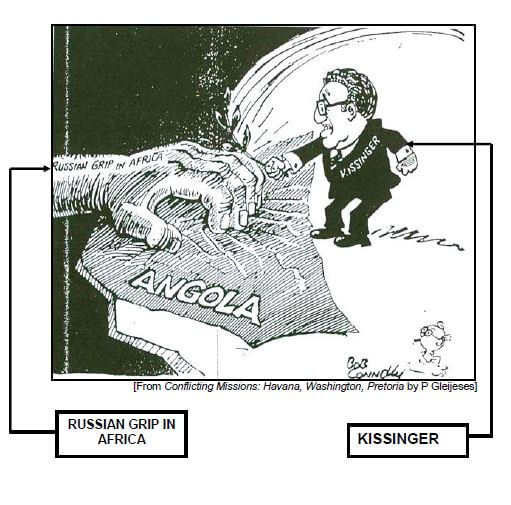
[From Conflicting Missions: Havana, Washington, Pretoria by P Gleijeses]
SOURCE 2D
This extract contains an explanation by Raul Diaz Arguelles, head of Decima Direccion (the special task force in charge of all Cuban military missions abroad) on why Cuba became involved in Angola from 1975.
'We arrived in Luanda, Angola, on Sunday, 3 August, and made contact with the MPLA,' Diaz Arguelles reported to Raul Castro … 'In our first conversation with Neto … we explained the purpose of our visit, which we based on the following points:
In the course of this conversation the Angolans complained about the paucity (lack) of aid from the socialist camp, and they pointed out that if the socialist camp does not help them … whereas the imperialists (USA) are helping the FNLA in every way possible. They also complained that the Soviet Union stopped helping them in 1972 and that the military aid is now sending is paltry (worthless), given the enormity (scale) of the need …' [From Conflicting Missions: Havana, Washington, Pretoria by P Gleijeses] |
QUESTION 3: WHAT WERE THE RESPONSES TO THE FORMATION OF THE BLACK PANTHER PARTY IN THE UNITED STATES OF AMERICA IN THE 1960s?
SOURCE 3A
The extract below describes the formation and the strategies of the Black Panther Party in the 1960s.
One of the most radical of all Black Power groups, the Black Panther Party, was founded by Huey Newton, age 24, and Bobby Searle, age 30, in Oaklands, California, in October 1966. In ideological terms Newton and Searle were strongly influenced by Malcolm X and revolutionaries like Che Guevara, Frantz Fanon and Mao Zedong. The principle demands of the Panthers were incorporated into a ten-point manifesto. The manifesto was nationalistic in tone. Individual aims in it included: a payment of reparations to African Americans by the federal government, as compensation for slavery; an exemption of blacks from military service; and freedom for blacks held in federal, state, county and city prisons, unless tried by a jury of their peers from within the black community … [From Black Civil Rights in America by K Verney] |
SOURCE 3B
The source below is taken from a Californian newspaper, The Sacramento Bee, which was published on 2 May 1967. The headline reads: 'CAPITOL IS INVADED' and the subheading reads: 'State Police Halt Armed Negro Band'.
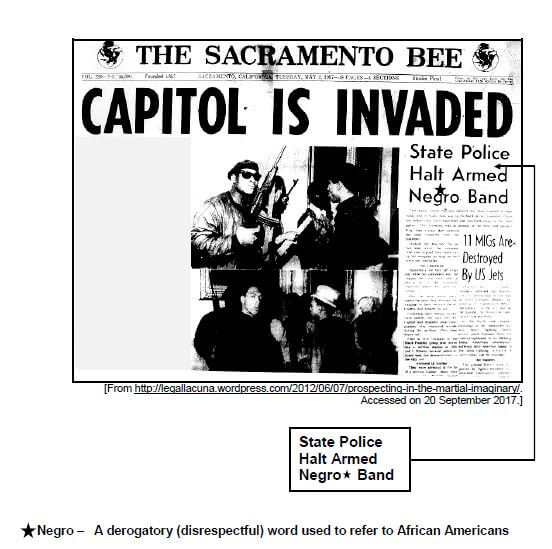
[From http://legallacuna.wordpress.com/2012/06/07/prospecting-in-the-martial-imaginary/. Accessed on 20 September 2017.]
SOURCE 3C
The extract below describes the community and political work that the Black Panther Party undertook in various states in the United States of America during the 1960s.
By 1970 the Black Panther Party had nearly 5 000 members in more than 20 states. From San Diego to New Haven, Panthers and sympathisers were active in scores of programmes and service projects … The Panthers made copious (many) attempts to meet people's fundamental needs. More than anything these programmes attracted people to the party. By 1969 the Black Panther Party had free breakfast programmes in 19 locations, feeding 20 000 children weekly. The Panthers developed liberation schools, as well as the celebrated free health clinics that provided free sickle-cell (a genetic disease mainly affecting people of African origin) testing in Chicago, Portland, Los Angeles, New York and other cities. [From Black Power, Radical Politics and African American Identity by JOG Ogbar] |
SOURCE 3D
The source below describes the action that was taken against the Black Panther Party by the Federal Bureau of Investigation (FBI) during the 1960s.
The FBI denounced (criticised) the Black Panther Party itself as a group of 'communist outlaws' bent (determined) on overthrowing the US government. [From http://www.lebbunawi.tumblr.com/post/111798191610/black-panthers-party-18-freedom-by-any means. Accessed on 20 September 2017.] |
ACKNOWLEDGEMENTS
Visual sources and other historical information were taken from the following:
Fensch, T. ed. 2001. The Kennedy – Khruschev Letters (New Century Books, The Woodlands, Texas)
Gleijeses, P. 2003. Conflicting Missions: Havana, Washington, Pretoria (Galago, Paarl)
http://history.state.gov/milestones/1969 - 1976/angola
http://ic.galegroup.com/ic/uhic/ReferenceDetailspage/ReferenceDetailsWindow?
http://legallacuna.wordpress.com/2012/06/07/prospecting-in-the-martial-imaginary
http://libguides.monroe2boces.org
http://www.lebbunawi.tumblr.com/post/111798191610/black-panthers-party-18- freedom-by-any-means
https://williamblum.org/chapters/killing-hope/angola
Mooney, M. 2006. On the Brink: from the Bay of Pigs to the Cuban Missile Crisis (HOT, University of California, Irvine)
Ogbar, JOG. 2005. Black Power, Radical Politics and African American Identity (Johns Hopkins University Press, Baltimore)
Verney, K. 2004. Black Civil Rights in America (Routledge, London)
HISTORY PAPER 2 GRADE 12 ADDENDUM - AMENDED SENIOR CERTIFICATE EXAMS PAST PAPERS AND MEMOS MAY/JUNE 2018
HISTORY
PAPER 2
GRADE 12
AMENDED SENIOR CERTIFICATE EXAMS
PAST PAPERS AND MEMOS
MAY/JUNE 2018
ADDENDUM
QUESTION 1: WHAT IMPACT DID THE PHILOSOPHY OF BLACK CONSCIOUSNESS (BC) HAVE ON SOUTH AFRICANS IN THE 1970s?
SOURCE 1A
The source below outlines the philosophy of Black Consciousness and how it influenced the formation of the South African Students' Organisation (SASO).
According to Bantu Stephen Biko, 'Black Consciousness seeks to show the black people the value of their own standards and outlook. It urges black people to judge themselves according to these standards and not to be fooled by white society who have white-washed themselves and made white standards the yardstick (measure) by which even black people judge each other.' [From http:// www.sahistory.org.za/topic/defining-black-consciousness. Accessed on 8 February 2018.] |
SOURCE 1B
The review below is of a speech delivered by Anne Heffernen of Onkgopotse Tiro (member of SASO) at Turfloop University in 1972. It focuses on how members of SASO felt about Bantu Education.
… By the early 1970s, thanks to SASO's organisation on the campus, Turfloop was a hotbed (centre) of activism. Boycotts and protest marches became a regular feature of student life. In 1972 the rural campus came to national attention. At the university's graduation that year, Onkgopotse Tiro, a SASO member and former president of the SRC, gave a fiery (powerful) speech condemning Bantu Education and its implementation at Turfloop. Tiro attacked the fact that a supposedly black university was controlled by white leadership, that white companies received contracts to supply the campus and that white dignitaries took seats from black parents who came to see their children graduate. [From http://aidc.org/turfloop-soweto-back-dialectic-1976/. Accessed on 9 February 2018.] |
SOURCE 1C
The photograph below shows students marching and demanding the release of fellow students who were detained by the apartheid regime. 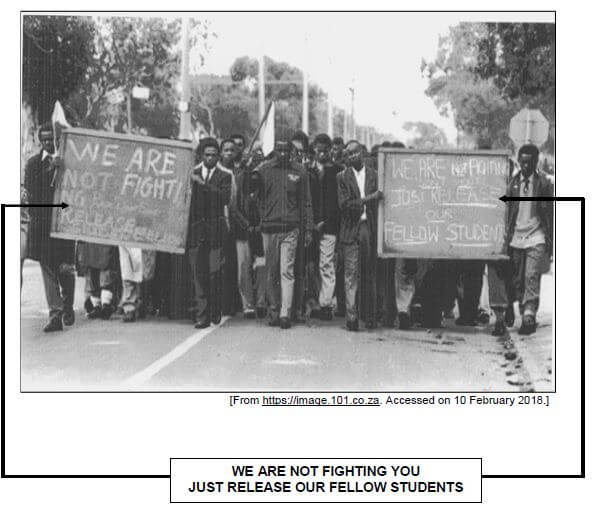
[From https://image.101.co.za. Accessed on 10 February 2018.]
SOURCE 1D
The extract below is a response by Bantu Stephen Biko on the success of the philosophy of Black Consciousness.
We have been successful to the extent that we have diminished the element of fear in the minds of black people. During the 1960s black people were terribly scared of involvement in politics. The universities were putting out no useful leadership to the black people because everybody found it more comfortable to lose themselves in a particular profession, to make money. But since those days, black students have seen their role as being primarily to prepare themselves for leadership roles in the various facets of the black community. Through our political articulation (expression) of the aspirations of black people, many black people have come to appreciate the need to stand up and be counted against the system. [From I Write What I Like: STEVE BIKO by A Stubbs ed.] |
QUESTION 2: HOW DID THE AMNESTY COMMITTEE OF THE TRUTH AND RECONCILIATION COMMISSION (TRC) DEAL WITH THE DEATH OF BANTU STEPHEN BIKO?
SOURCE 2A
The extract below focuses on the reasons for the formation of the Truth and Reconciliation Commission (TRC).
The Truth and Reconciliation Commission (TRC) was formed in 1995 to investigate human rights violations since 1960 and to grant amnesty to those perpetrators who made full disclosure. The commission also had to foster reconciliation and unity among South Africans. In exchange for full confessions of politically motivated crimes, the TRC promised amnesty for those who came forward. In 1997 the five former security officers who interrogated Steven Biko on 6 September 1967 applied for amnesty from the TRC. The TRC's mandate was to be even-handed, but its composition was hardly balanced. The chairman, Archbishop Desmond Tutu, was a patron of the United Democratic Front, the ANC's internal front since the early 1980s … [From Race and Reconciliation by D Herwitz] |
SOURCE 2B
The extract below is part of a statement that the Truth and Reconciliation Commission issued. It focuses on the application for amnesty by the five security policemen who were responsible for the killing of Bantu Stephen Biko.
In January 1997, a group of notorious (ruthless) security policemen from the regional headquarters in Port Elizabeth applied for amnesty for a string of murders in the Eastern Cape. For years their names had struck terror in the townships as they cruised (went) about acting with impunity (without approval). Now their only hope of avoiding prosecution was to testify before the Truth and Reconciliation Commission. [From http://www.justice.gov.za/trc/media/pr/1999/p990216a.htm. Accessed on 9 December 2017.] |
SOURCE 2C
This source focuses on why amnesty was not granted to four security policemen responsible for the killing of Bantu Stephen Biko.
AMNESTY DECISION ON DEATH OF STEVE BIKO Four former officers of the security branch, who applied for amnesty for the murder of Black Consciousness leader Bantu Stephen Biko in September 1997, were this week refused amnesty by the Amnesty Committee of the TRC and their applications were dismissed.
[From http://www.justice.gov.za/trc/media/pr/1999/p990216a.htm. Accessed on 28 November 2017.] |
SOURCE 2D
The cartoon below by Stidy depicts the commemoration of the 20th anniversary of the killing of the Black Consciousness leader Bantu Stephen Biko. It appeared in Over The Rainbow – The First 10 Years of South Africa's Democracy in Cartoons and was produced on 12 September 1997. 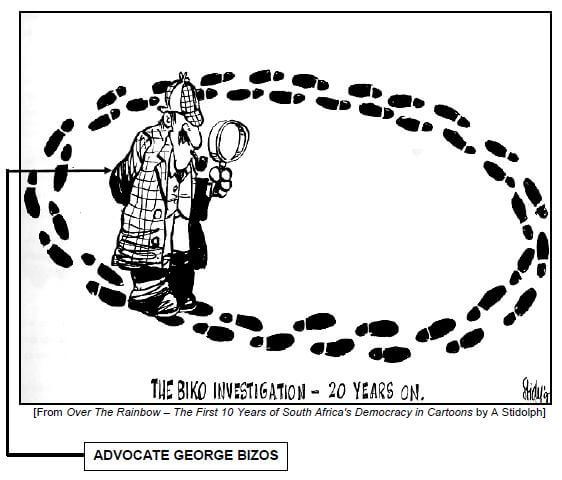
QUESTION 3: HOW WAS SOUTH AFRICA'S CLOTHING AND TEXTILE INDUSTRY AFFECTED BY GLOBALISATION?
SOURCE 3A
The article below focuses on the impact that trade liberalisation had on the clothing and textile industry in South Africa. It was written by the Minister of Economic Development, E Patel, for The Journalist.
Before the transition (change) to democracy, the clothing and textile industry employed roughly 250 000 workers. It was supported by very high tariffs that kept foreign goods out, very low wages that kept costs down and substantial financial subsidies that kept businesses alive, particularly in the old homelands areas … which were not sustainable from the mid-1980s onwards. [From http://www.thejournalist.org.za/spotlight/unravelling-the-fabric-of-the-industry-south-africas clothing-and-textile-business. Accessed on 20 January 2018.] |
SOURCE 3B
The source below is a part of a transcript of an interview that E Vlok, the Director of Research, Southern African Clothing and Textile Workers' Union, gave on Cape Talk Radio on 6 April 2017. It outlines how globalisation impacted on South Africa's clothing and textile industry.
SOUTH AFRICAN CLOTHING AND TEXTILE INDUSTRY DROPS FROM 200 000 JOBS TO 19 000 Ettienne Vlok, Director of Research at the Southern African Clothing and Textile Workers' Union, spoke with Azania Mosaka about the challenges facing the textile industry. [From http://www.702.co.za/articles/251378/sa-clothing-and -textile-industry-drops-from-200-000-to 19-000-jobs-researcher. Accessed on 20 January 2018.] |
SOURCE 3C
The photograph below, by K Mogale, appeared on the web blog of Eye Witness News. It shows members of the Congress of South African Trade Union (COSATU) and the South African Clothing and Textile Workers Union (SACTWU) marching in Cape Town on 7 October 2017.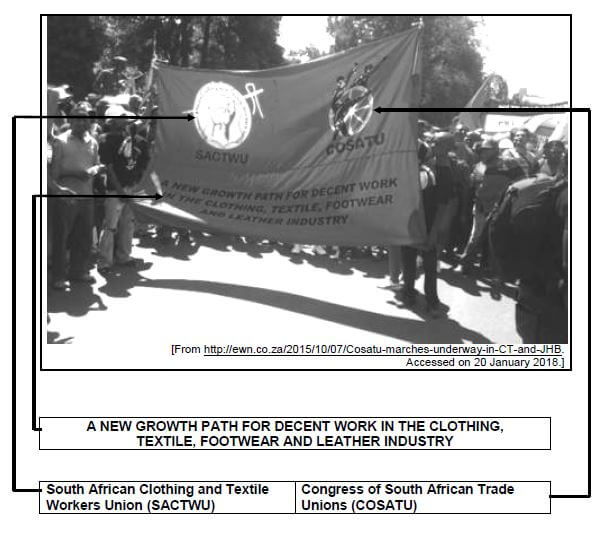
SOURCE 3D
This article focuses on the measures that the South African government took to bring about a turnaround in the clothing and textile industry. It appeared in the City Press on 11 October 2017.
The Minister in the Presidency for Planning, Monitoring and Evaluation, Jeff Radebe, highlighted the clothing and textile industry as one of the sectors where the economy could most effectively be bolstered (boosted). [From https://www.fin24.com/Opinion/the-great-textile-turnaround-20171011. Accessed on 20 January 2018.] |
ACKNOWLEDGEMENTS
Visual sources and other historical evidence were taken from the following:
Herwitz D. 2003. Race and Reconciliation (University of Minnesota Press)
http://aidc.org/turfloop-soweto-back-dialectic-1976/
http://ewn.co.za/2015/10/07/Cosatu-marches-underway-in-CT-and-JHB
http://www.justice.gov.za/trc/media/pr/1999/p990216a.htm
http:// www.sahistory.org.za/topic/defining-black-consciousness
http://www.thejournalist.org.za/spotlight/unravelling-the-fabric-of-the-industry-south africas-clothing-and-textile-business
http://www.702.co.za/articles/251378/sa-clothing-and -textile-industry-drops-from-200- 000-to-19-000-jobs-researcher
https://image.101.co.za
https://www.fin24.com/Opinion/the-great-textile-turnaround-20171011
Stidolph A. 2003. Over The Rainbow – The First 10 years of South Africa's Democracy In Cartoons (Pietermaritzburg)
Stubbs A. (ed.) 2004. I Write What I Like: STEVE BIKO (Picador Africa)
HISTORY PAPER 2 GRADE 12 QUESTIONS - AMENDED SENIOR CERTIFICATE EXAMS PAST PAPERS AND MEMOS MAY/JUNE 2018
HISTORY
PAPER 2
GRADE 12
AMENDED SENIOR CERTIFICATE EXAMS
PAST PAPERS AND MEMOS
MAY/JUNE 2018
INSTRUCTIONS AND INFORMATION
- This question paper consists of SECTION A and SECTION B based on the prescribed content framework in the CAPS document.
SECTION A: SOURCE-BASED QUESTIONS
QUESTION 1: CIVIL RESISTANCE, 1970s TO 1980s: SOUTH AFRICA
QUESTION 2: THE COMING OF DEMOCRACY TO SOUTH AFRICA AND COMING TO TERMS WITH THE PAST
QUESTION 3: THE END OF THE COLD WAR AND A NEW WORLD ORDER, 1989 TO THE PRESENT
SECTION B: ESSAY QUESTIONS
QUESTION 4: CIVIL RESISTANCE, 1970s TO 1980s: SOUTH AFRICA: THE CRISIS OF APARTHEID IN THE 1980s
QUESTION 5: THE COMING OF DEMOCRACY TO SOUTH AFRICA AND COMING TO TERMS WITH THE PAST
QUESTION 6: THE END OF THE COLD WAR AND A NEW WORLD ORDER: THE EVENTS OF 1989 - SECTION A consists of THREE source-based questions. Source material that is required to answer these questions may be found in the ADDENDUM.
- SECTION B consists of THREE essay questions.
- Answer THREE questions as follows:
4.1 At least ONE must be a source-based question and at least ONE must be an essay question.
4.2 The THIRD question may be either a source-based question or an essay question. - You are advised to spend at least ONE hour per question.
- When answering questions, you should apply your knowledge, skills and insight.
- You will be disadvantaged by merely rewriting the sources as answers.
- Number the answers correctly according to the numbering system used in this question paper.
- Write neatly and legibly.
QUESTIONS
SECTION A: SOURCE-BASED QUESTIONS
Answer at least ONE question, but not more than TWO questions, in this section. Source material to be used to answer these questions is contained in the ADDENDUM.
QUESTION 1: WHAT IMPACT DID THE PHILOSOPHY OF BLACK CONSCIOUSNESS (BC) HAVE ON SOUTH AFRICANS IN THE 1970s?
Study Sources 1A, 1B, 1C and 1D and answer the questions that follow. 1.1 Refer to Source 1A.
1.1.1 Explain the concept Black Consciousness in your own words. (1 x 2) (2)
1.1.2 Why was Bantu Stephen Biko regarded as a 'highly respected intellectual'? Give TWO reasons from the source. (2 x 1) (2)
1.1.3 Using the information in the source and your own knowledge, explain why it was important for Biko to restore the 'pride' and 'culture' of black South Africans. (2 x 2) (4)
1.1.4 Comment on why you think NUSAS was critical about the apartheid government's actions. (2 x 2) (4)
1.2 Read Source 1B.
1.2.1Identify TWO forms of protest that the students embarked on at Turfloop University during the 1970s. (2 x 1) (2)
1.2.2 How, according to the source, did the following people respond to Tiro's expulsion:
(a) Black academics (1 x 2) (2)
(b) Students at Turfloop University (1 x 2) (2)
1.2.3 Explain the impact that the student uprising at Turfloop University had on SASO. (2 x 2) (4)
1.2.4 Comment on why you think this source would be useful to a historian researching about the role of SASO. (2 x 2) (4)
1.3 Study Source 1C.
1.3.1 How, according to the photograph, did students protest against Bantu Education? (1 x 2) (2)
1.3.2 Using the information in the source and your own knowledge comment on the words on the placard: 'WE ARE NOT FIGHTING YOU JUST RELEASE OUR FELLOW STUDENTS' in the context of student protests. (2 x 2) (4)
1.4 Compare Sources 1B and 1C. Explain how the information in Source 1B supports the evidence in Source 1C regarding the impact of SASO. (2 x 2) (4)
1.5 Use Source 1D.
1.5.1 Why, according to the source, was the philosophy of Black Consciousness successful? (1 x 2) (2)
1.5.2 Comment on why you think many black South Africans decided to stand up against the apartheid government. (1 x 2) (2)
1.5.3 What TWO methods, according to the source, did the apartheid government use to suppress students protests? (2 x 1) (2)
1.6 Using the information in the relevant sources and your own knowledge, write a paragraph of about EIGHT lines (about 80 words) explaining the impact that the philosophy of Black Consciousness had on South Africans in the 1970s. (8) [50]
QUESTION 2: HOW DID THE AMNESTY COMMITTEE OF THE TRUTH AND RECONCILIATION COMMISSION (TRC) DEAL WITH THE DEATH OF BANTU STEPHEN BIKO?
Study Sources 2A, 2B, 2C and 2D and answer the questions that follow. 2.1 Refer to Source 2A.
2.1.1 Quote TWO reasons from the source for the formation of the TRC in 1995. (2 x 1) (2)
2.1.2 Define the concept reconciliation in the context of the TRC hearings. (1 x 2) (2)
2.1.3 Comment on Herwitz's claim that the composition of the TRC was 'hardly balanced'. (2 x 2) (4)
2.1.4 Explain why you think the TRC hearings served an important 'symbolic function' in South Africa. (2 x 2) (4)
2.1.5 Why, according to the information in the source, did more than one thousand perpetrators receive amnesty? (1 x 2) (2)
2.2 Consult Source 2B.
2.2.1 What prompted the security policemen from Port Elizabeth to apply for amnesty? (1 x 2) (2)
2.2.2.Name any FOUR of the security policemen in the source that appeared before the Amnesty Committee of the TRC for the murder of Bantu Stephen Biko. (4 x 1) (4)
2.2.3 Explain why you think George Bizos decided to oppose the amnesty application of the security policemen. (2 x 2) (4)
2.3 Read Source 2C.
2.3.1 Why, according to the information in the source, were the four security policemen refused amnesty for the murder of Biko? (1 x 2) (2)
2.3.2 Comment on why you would regard the information in the source as useful when researching the amnesty hearings of the TRC. (2 x 2) (4)
2.4 Refer to Sources 2B and 2C. Explain how the information in Source 2B supports the evidence in Source 2C regarding the amnesty hearings of the security policemen. (2 x 2) (4)
2.5 Study Source 2D.
2.5.1 Explain the messages that are conveyed in the cartoon. Use the visual clues in the source to support your answer. (2 x 2) (4)
2.5.2 Comment on why you think the cartoon is titled 'THE BIKO INVESTIGATION – 20 YEARS ON'. (2 x 2) (4)
2.6 Using the information in the relevant sources and your own knowledge, write a paragraph of about EIGHT lines (about 80 words) explaining how the Amnesty Committee of the TRC dealt with the death of Bantu Stephen Biko. (8) [50]
QUESTION 3: HOW WAS SOUTH AFRICA'S CLOTHING AND TEXTILE INDUSTRY AFFECTED BY GLOBALISATION?
Study Sources 3A, 3B, 3C and 3D and answer the questions that follow. 3.1 Refer to Source 3A.
3.1.1 Name any TWO factors in the source that made it possible for South Africa's clothing and textile industry to operate before 1994. (2) (2 x 1)
3.1.2 What were the outcomes of the global trade talks in which South Africa took part in 1993? (2 x 1) (2)
3.1.3 Using the information in the source and your own knowledge, explain why the trade unions and Nelson Mandela wanted to protect the local clothing and textile industry in 1993. (2 x 2) (4)
3.1.4 Comment on the impact that the opening of South Africa's markets had on the clothing and textile industry in the 1990s. (2 x 2) (4)
3.2 Study Source 3B.
3.2.1 State TWO ways in the source that indicate how South Africa's clothing and textile industry was affected. (2 x 1) (2)
3.2.2 Using the information in the source and your own knowledge, explain why South Africa's clothing and textile industry was regarded as 'unique'. (2 x 2) (4)
3.2.3 What, according to Vlok, was the major challenge facing South Africa's clothing and textile industry? (1 x 2) (2)
3.3 Compare Sources 3A and 3B. Explain how the information in Source 3A and Source 3B is similar regarding the impact that globalisation had on South Africa's clothing and textile industry. (2 x 2) (4)
3.4 Use Source 3C.
3.4.1 Explain why you think this photograph was taken. (2 x 2) (4)
3.4.2 Comment on what is implied by the caption on the banner: 'A NEW GROWTH PATH FOR DECENT WORK IN THE CLOTHING, TEXTILE, FOOTWEAR AND LEATHER INDUSTRY.' (2 x 2) (4)
3.5 Consult Source 3D.
3.5.1 Explain the term globalisation in your own words. (1 x 2) (2)
3.5.2 Quote any TWO reasons from the source that contributed to the (2)
3.5.3 decline of South Africa's clothing and textile industry. (2 x 1)
3.5.4 Select TWO pieces of evidence from the source that suggest that the implementation of the CTCP was a success. (2 x 1) (2)
3.5.5 Comment on the usefulness of the information in the source for a historian studying the impact that the South African government had on the clothing and textile industry. (2 x 2) (4)
3.6 Using the information in the relevant sources and your own knowledge, write a paragraph of about EIGHT lines (about 80 words) explaining how South Africa's clothing and textile industry was affected by globalisation. (8) [50]
SECTION B: ESSAY QUESTIONS
Answer at least ONE question, but not more than TWO questions, in this section. Your essay should be about THREE pages long.
QUESTION 4: CIVIL RESISTANCE, 1970s TO 1980s: SOUTH AFRICA: THE CRISIS OF APARTHEID IN THE 1980s
The international anti-apartheid movement played a significant role in ensuring the downfall of the apartheid regime in the 1980s. Do you agree with this statement? Substantiate your line of argument by using relevant evidence. [50]
QUESTION 5: THE COMING OF DEMOCRACY TO SOUTH AFRICA AND COMING TO TERMS WITH THE PAST
The violence that erupted in various parts of South Africa during the early 1990s nearly derailed the birth of a democratic dispensation in 1994. Critically discuss the statement in the context of the process of negotiations between various political organisations between 1990 and 1994. [50]
QUESTION 6: THE END OF THE COLD WAR AND A NEW WORLD ORDER: THE EVENTS OF 1989
Explain to what extent Gorbachev's reforms in the Soviet Union during the 1980s contributed to political changes that occurred in South Africa after 1989. Support your line of argument with relevant evidence. [50]
TOTAL: 150
HISTORY PAPER 1 GRADE 12 QUESTIONS - AMENDED SENIOR CERTIFICATE EXAMS PAST PAPERS AND MEMOS MAY/JUNE 2018
HISTORY
PAPER 1
GRADE 12
AMENDED SENIOR CERTIFICATE EXAMS
PAST PAPERS AND MEMOS
MAY/JUNE 2018
INSTRUCTIONS AND INFORMATION
- This question paper consists of SECTION A and SECTION B based on the prescribed content framework in the CAPS document.
SECTION A: SOURCE-BASED QUESTIONS
QUESTION 1: THE COLD WAR: CONTAINMENT AND BRINKMANSHIP: THE CUBAN MISSILE CRISIS
QUESTION 2: INDEPENDENT AFRICA: CASE STUDY – ANGOLA
QUESTION 3: CIVIL SOCIETY PROTESTS FROM THE 1950s TO THE 1970s: THE BLACK POWER MOVEMENT
SECTION B: ESSAY QUESTIONS
QUESTION 4: CASE STUDY – CHINA
QUESTION 5: INDEPENDENT AFRICA: COMPARATIVE CASE STUDY – THE CONGO AND TANZANIA
QUESTION 6: CIVIL SOCIETY PROTESTS FROM THE 1950s TO THE 1970s: THE CIVIL RIGHTS MOVEMENT - SECTION A consists of THREE source-based questions. Source material that is required to answer these questions can be found in the ADDENDUM.
- SECTION B consists of THREE essay questions.
- Answer THREE questions as follows:
4.1 At least ONE must be a source-based question and at least ONE must be an essay question.
4.2 The THIRD question may be either a source-based question or an essay question. - You are advised to spend at least ONE hour per question.
- When answering the questions, you should apply your knowledge, skills and insight.
- You will be disadvantaged by merely rewriting the sources as answers.
- Number the answers correctly according to the numbering system used in this question paper.
- Write neatly and legibly.
QUESTIONS
SECTION A: SOURCE-BASED QUESTIONS
Answer at least ONE question, but not more than TWO questions, in this section. Source material that is required to answer these questions can be found in the ADDENDUM.
QUESTION 1: WHY DID CUBA BECOME THE FOCAL POINT OF THE COLD WAR BETWEEN THE UNITED STATES OF AMERICA AND THE SOVIET UNION IN THE 1960s?
Study Sources 1A, 1B, 1C and 1D and answer the questions that follow. 1.1 Use Source 1A.
1.1.1 Why, according to the source, did President Eisenhower make thirteen million dollars available to the CIA? (2 x 1) (2)
1.1.2 Identify the TWO countries where the CIA trained Cuban exiles to carry out the invasion of Cuba. (2 x 1) (2)
1.1.3 Why do you think President Kennedy allowed the CIA to continue with the invasion of Cuba? (2 x 2) (4)
1.1.4 Explain the concept American imperialism in the context of the Cuban Missile Crisis. (1 x 2) (2)
1.2 Read Source 1B.
1.2.1 Quote THREE pieces of evidence from the source that suggest the Soviet government was angry about the tactics the US government used against Cuba. (3 x 1) (3)
1.2.2 Using the information in the source and your own knowledge, explain how Khrushchev wanted to eliminate 'the danger of war'. (2 x 2) (4)
1.2.3 Explain why a historian would consider the information in this source useful when researching the Soviet Union's decision to support Cuba during the Cold War. (2 x 2) (4)
1.3 Study Sources 1A and 1B. Explain how the information in Source 1A and Source 1B differs regarding the relationship that the United States of America and the Soviet Union had with Cuba. (2 x 2) (4)
1.4 Consult Source 1C.
1.4.1Why, according to the source, did Castro request assistance from Khrushchev? Give THREE reasons. (3 x 1) (3)
1.4.2 Using the information in the source and your own knowledge, comment on how the United States of America found out about the construction of missile sites in Cuba. (2 x 2) (4)
1.4.3 How did President Kennedy and his advisors react to the discovery of the missile sites in Cuba? Quote TWO phrases from the source. (2 x 1) (2)
1.5 Refer to Source 1D.
1.5.1 Explain why the USA decided to impose a naval blockade on Soviet ships that attempted to enter Cuba in 1962. (2 x 2) (4)
1.5.2 Using the information in the source and your own knowledge, explain the impact that the US military bases had on Cuba. (2 x 2) (4)
1.6 Using the information in the relevant sources and your own knowledge, write a paragraph of about EIGHT lines (about 80 words) explaining why Cuba became the focal point of the Cold War between the United States of America and the Soviet Union in the 1960s. (8) [50]
QUESTION 2: HOW DID THE INTERVENTION BY FOREIGN POWERS INTENSIFY COLD WAR TENSIONS IN ANGOLA BETWEEN 1974 AND 1976?
Study Sources 2A, 2B, 2C and 2D and answer the questions that follow. 2.1 Use Source 2A.
2.1.1 Explain the concept independence, in the context of Angola in the 1970s. (1 x 2) (2)
2.1.2 Name the THREE military movements in the source that fought for Angola's independence from colonial rule. (3 x 1) (3)
2.1.3 Give TWO provisions of the Alvor Agreement, as quoted in the source. (2 x 1) (2)
2.1.4 Using the information in the source and your own knowledge, explain what is implied by the phrase 'Angola developed into a Cold War battleground'. (2 x 2) (4)
2.2 Consult Source 2B.
2.2.1 According to the information in the source, which Angolan liberation movement received weapons from the CIA in July 1975? (1 x 1) (1)
2.2.2 Quote THREE ways from the source which show that the United States of America supported UNITA. (3 x 1) (3)
2.2.3 Using the information in the source and your own knowledge, explain why the CIA spread false information about the Soviet Union and Cuba. (2 x 2) (4)
2.3 Refer to Source 2C.
Using the visual clues in the source, explain the messages that are conveyed in the cartoon regarding:
2.3.1 The Soviet Union's (Russia's) involvement in Angola (2 x 2) (4)
2.3.2 The United States of America's reaction to the Soviet Union's involvement in Angola (2 x 2) (4)
2.4 Read Source 2D.
2.4.1 Identify the Angolan liberation movement in the source which requested support from Cuba. (1 x 1) (1)
2.4.2 Why, according to the source, did a Cuban delegation visit Angola in August 1975? (2 x 1) (2)
2.4.3 Using the information in the source and your own knowledge, explain why Cuba was willing to give Agostinho Neto 'dramatically' more military support than he had asked for. (2 x 2) (4)
2.4.4 Comment on the usefulness of this source for a historian researching the involvement of foreign powers in the Angolan civil war. (2 x 2) (4)
2.5 Study Sources 2C and 2D. Explain how the evidence in Source 2C differs from the information in Source 2D regarding the involvement of foreign powers in the Angolan Civil War. (2 x 2) (4)
2.6 Using the information in the relevant sources and your own knowledge, write a paragraph of about EIGHT lines (about 80 words) explaining how the intervention by foreign powers intensified Cold War tensions in Angola between 1974 and 1976. (8) [50]
QUESTION 3: WHAT WERE THE RESPONSES TO THE FORMATION OF THE BLACK PANTHER PARTY IN THE UNITED STATES OF AMERICA IN THE 1960s?
Study Sources 3A, 3B, 3C and 3D and answer the questions that follow. 3.1 Read Source 3A.
3.1.1 Explain the concept Black Power in the context of the formation of the Black Panther Party. (1 x 2) (2)
3.1.2 Quote TWO leaders from the source that formed the Black Panther Party in 1966. (2 x 1) (2)
3.1.3 Using the information in the source, state any TWO demands in the Black Panther Party's ten-point manifesto. (2 x 1) (2)
3.1.4 Why do you think the actions of the Black Panther Party resulted in 'tense relations with law-enforcement agencies'? (2 x 2) (4)
3.2 Use Source 3B.
3.2.1 Explain why this article was published on the front page of The Sacramento Bee newspaper. (2 x 2) (4)
3.2.2 Comment on the newspaper headline 'CAPITOL IS INVADED' in the context of the strategy that was adopted by the Black Panther Party. (2 x 2) (4)
3.3 Refer to Sources 3A and 3B. Explain how the evidence in Source 3A supports the information in Source 3B regarding strategies that the Black Panther Party used. (2 x 2) (4)
3.4 Consult Source 3C.
3.4.1 Identify any TWO phrases in the source that suggest the Black Panther Party had widespread support in the United States of America in the 1970s. (2 x 1) (2)
3.4.2 List any THREE community projects in the source that were started by the Black Panther Party. (3 x 1) (3)
3.4.3 Using the information in the source and your own knowledge, explain why young people saw the Black Panther Party as the 'vanguard (spearhead) of the revolution'. (2 x 2) (4)
3.5 Study Source 3D.
3.5.1 Quote evidence from the source that suggests the FBI was critical of the Black Panther Party. (1 x 1) (1)
3.5.2 Explain why you think Hoover stated that the Black Panther Party represented 'the greatest threat to the internal security of the US'. (2 x 2) (4)
3.5.3 State any TWO actions in the source that police raiders took to destroy the Black Panther Party. (2 x 1) (2)
3.5.4 Comment on why a historian would find this source useful when researching about the FBI's reaction to the Black Panther Party. (2 x 2) (4)
3.6 Using the information in the relevant sources and your own knowledge, write a paragraph of about EIGHT lines (about 80 words) explaining the responses to the formation of the Black Panther Party in the United States of America in the 1960s. (8) [50]
SECTION B: ESSAY QUESTIONS
Answer at least ONE question, but not more than TWO questions in this section. Your essay should be about THREE pages long.
QUESTION 4: CASE STUDY – CHINA
Critically discuss the implementation of Mao Zedong's policies, the 'Great Leap Forward' and the 'Cultural Revolution' in the People's Republic of China between 1957 and 1969. [50]
QUESTION 5: INDEPENDENT AFRICA: COMPARATIVE CASE STUDY – THE CONGO AND TANZANIA
Explain to what extent Tanzania was more successful than the Congo in addressing the political, economic and social challenges that confronted them after attaining independence in the early 1960s. Support your line of argument with relevant evidence. [50]
QUESTION 6: CIVIL SOCIETY PROTESTS FROM THE 1950s TO THE 1970s: THE CIVIL RIGHTS MOVEMENT
The sit-ins were the only form of non-violent protest that was successfully used by civil rights activists in the 1960s to bring an end to segregation and discrimination in the United States of America. Do you agree with the statement? Support your line of argument with relevant evidence. [50]
TOTAL: 150
HISTORY PAPER 1 GRADE 12 MEMORANDUM - AMENDED SENIOR CERTIFICATE EXAMS PAST PAPERS AND MEMOS MAY/JUNE 2018
HISTORY
PAPER 1
GRADE 12
AMENDED SENIOR CERTIFICATE EXAMS
PAST PAPERS AND MEMOS
MAY/JUNE 2018
MEMORANDUM
1. SOURCE-BASED QUESTIONS
1.1 The following cognitive levels were used to develop source-based questions:
Cognitive Levels | Historical skills | Weighting |
LEVEL 1 |
| 30% (15) |
LEVEL 2 |
| 40% (20) |
LEVEL 3 |
| 30% (15) |
1.2 The information below indicates how source-based questions are assessed:
- In the marking of source-based questions, credit needs to be given to any other valid and relevant viewpoints, arguments, evidence or examples.
- In the allocation of marks, emphasis should be placed on how the requirements of the question have been addressed.
- In the marking guideline, the requirements of the question (skills that need to be addressed) as well as the level of the question are indicated in italics.
- When assessing open-ended source-based questions, learners should be credited for any other relevant answers.
- Learners are expected to take a stance when answering ‘to what extent’ questions in order for any marks to be awarded.
1.3 Assessment procedures for source-based questions
- Use a tick (✔) for each correct answer.
- Pay attention to the mark scheme e.g. (2 x 2) which translates to two reasons and is given two marks each (✔✔✔✔); (1 x 2) which translates to one reason and is given two marks (✔✔).
- If a question carries 4 marks then indicate by placing 4 ticks (✔✔✔✔).
Paragraph question
Paragraphs are to be assessed globally (holistically). Both the content and structure of the paragraph must be taken into account when awarding a mark. The following steps must be used when assessing a response to a paragraph question:
- Read the paragraph and place a bullet (.) at each point within the text where the candidate has used relevant evidence to address the question.
- Re-read the paragraph to evaluate the extent to which the candidate has been able to use relevant evidence to write a paragraph.
- At the end of the paragraph indicate the ticks (√) that the candidate has been awarded for the paragraph; as well as the level (1,2, or 3) as indicated in the holistic rubric and a brief comment e.g.
______________________________________ . _________________________ _________________ . ____________________________ . _________________ Level 2 √√√√√
Used mostly relevant evidence to write a basic paragraph - Count all the ticks for the source-based question and then write the mark on the right hand bottom margin e.g. 32/ 50
- Ensure that the total mark is transferred accurately to the front/back cover of the answer script.
2. ESSAY QUESTIONS
2.1 The essay questions require candidates to:
- Be able to structure their argument in a logical and coherent manner. They need to select, organise and connect the relevant information so that they are able to present a reasonable sequence of facts or an effective argument to answer the question posed. It is essential that an essay has an introduction, a coherent and balanced body of evidence and a conclusion.
2.2 Marking of essay questions
- Markers must be aware that the content of the answer will be guided by the textbooks in use at the particular centre.
- Candidates may have any other relevant introduction and/or conclusion than those included in a specific essay marking guideline for a specific essay.
2.3 Global assessment of the essay
The essay will be assessed holistically (globally). This approach requires the teacher to assess the essay as a whole, rather than assessing the main points of the essay separately. This approach encourages the learner to write an original argument by using relevant evidence to support the line of argument. The learner will not be required to simply regurgitate content (facts) in order to achieve a level 7 (high mark). This approach discourages learners from preparing essays and reproducing them without taking the specific requirements of the question into account. Holistic marking of the essay credits learners' opinions that are supported by evidence. Holistic assessment, unlike content-based marking, does not penalise language inadequacies as the emphasis is on the following:
- The learner's interpretation of the question
- The appropriate selection of factual evidence (relevant content selection)
- The construction of an argument (planned, structured and has an independent line of argument)
2.4 Assessment procedures of the essay
2.4.1 Keep the synopsis in mind when assessing the essay.
2.4.2 During the reading of the essay, ticks need to be awarded for a relevant introduction (which is indicated by a bullet in the marking guideline), the main aspects/body of the essay that sustains/defends the line of argument (which is indicated by bullets in the marking guideline) and a relevant conclusion (which is indicated by a bullet in the marking guideline).
For example in an essay where there are five (5) main points there could be about seven (7) ticks.
2.4.3 Keep the PEEL structure in mind in assessing an essay.
P | Point: The candidate introduces the essay by taking a line of argument/making a major point. Each paragraph should include a point that sustains the major point (line of argument) that was made in the introduction. |
E | Explanation: The candidate should explain in more detail what the main point is about and how it relates to the question posed (line of argument). |
E | Example: Candidates should answer the question by selecting content that is relevant to the line of argument. Relevant examples should be given to sustain the line of argument. |
L | Link: Candidates should ensure that the line of argument is sustained throughout and is written coherently. |
2.4.4 The following additional symbols can also be used:
- Introduction, main aspects and conclusion not properly contextualised ^
- Wrong statement _________________
- Irrelevant statement |
|
| - Repetition R
- Analysis A√
- Interpretation I√
- Line of Argument LOA
2.5 The matrix
2.5.1 Use of the matrix in the marking of essays
In the marking of essays, the criteria as provided in the matrix should be used. When assessing the essay note both the content and presentation. At the point of intersection of the content and presentation based on the seven competency levels, a mark should be awarded.
(a) The first reading of the essay will be to determine to what extent the main aspects have been covered and to allocate the content level (on the matrix).
C | LEVEL 4 | |
(b) The second reading of the essay will relate to the level (on the matrix) of presentation.
C | LEVEL 4 | |
P | LEVEL 3 |
(c) Allocate an overall mark with the use of the matrix.
C | LEVEL 4 | }26–27 |
P | LEVEL 3 |
GLOBAL ASSESSMENT OF ESSAYS: TOTAL MARKS: 50
PRESENTATION
CONTENT | LEVEL 7
| LEVEL 6
| LEVEL 5
| LEVEL 4
| LEVEL 3
| LEVEL 2
| LEVEL 1*
|
LEVEL 7
| 47–50 | 43–46 | |||||
LEVEL 6
| 43–46 | 40–42 | 38–39 | ||||
LEVEL 5
| 38–39 | 36–37 | 34–35 | 30–33 | 28–29 | ||
LEVEL 4
| 30–33 | 28–29 | 26–27 | ||||
LEVEL 3
| 26–27 | 24–25 | 20–23 | ||||
LEVEL 2
| 20–23 | 18–19 | 14–17 | ||||
LEVEL 1*
| 14–17 | 0–13 |
*Guidelines for allocating a mark for Level 1:
- Question not addressed at all/totally irrelevant content; no attempt to structure the essay = 0
- Content selection includes basic and generally irrelevant information; no attempt to structure the essay = 1–6
- Question inadequately addressed and vague; little attempt to structure the essay = 7–13
SECTION A: SOURCE-BASED QUESTIONS
QUESTION 1: WHY DID CUBA BECOME THE FOCAL POINT OF THE COLD WAR BETWEEN THE UNITED STATES OF AMERICA AND THE SOVIET UNION IN THE 1960s?
1.1.1 [Extraction of evidence from Source 1A – L1]
- 'To train Cuban exiles'
- 'To carry out an invasion of Cuba'
- 'Oust (remove) Castro' (any 2 x 1) (2)
1.1.2 [Extraction of evidence from Source 1A – L1]
- ‘Guatemala’
- ‘Nicaragua’ (2 x 1) (2)
1.1.3 [Interpretation of evidence in Source 1A – L2]
- Kennedy inherited the Cuban problem from Eisenhower/Kennedy had to complete Eisenhower’s work
- To show the USA's power and prestige over Cuba
- Kennedy wanted to be seen as a strong leader in the USA and the whole world
- Kennedy wanted to remove Castro and make it appear that the US government played no part in the invasion
- To stop the spread of communism
- Any other relevant response (any 2 x 2) (4)
1.1.4 [Explanation of a historical concept in Source 1A – L1]
- America's attempt to control Cuba politically by removing Castro and entrenching democracy
- America attempted to spread and entrench its capitalist ideology on Cuba
- America attempted to prevent the spread of Communism to Cuba
- Any other relevant response (any 1 x 2) (2)
1.2.1 [Extraction of evidence from Source 1B – L1]
- 'Armed aggression has begun against Cuba'
- 'Armed bands invading this country were trained, equipped and armed in the United States of America'
- 'The planes which are bombing Cuban cities belong to the United States of America'
- 'The bombs they are dropping are being supplied by the American government' (any 3 x 1) (3)
1.2.2 [Interpretation of evidence in Source 1B – L2]
- Khrushchev wanted the USA and the Soviet Union to work together to resolve (to negotiate) the crisis in Cuba
- Khrushchev wanted the USA to respect Cuba's sovereignty
- Encouraged the USA to work with Cuba in a harmonious manner
- Any other relevant response (any 2 x 2) (4)
1.2.3 [Evaluate the usefulness of Source 1B – L3]
The source is USEFUL because:
- It gives first-hand information (letter) from Nikita Khrushchev to President Kennedy
- The letter was written at the time of the Cuban invasion, 18 April 1961
- It gives insight into how the Soviet Union supported Cuba immediately after the invasion of Cuba by the USA
- It highlights how Khrushchev blamed the USA for armed aggression against Cuba
- Any other relevant response (any 2 x 2) (4)
1.3 [Comparison of evidence in Sources 1A and 1B – L3]
- In Source 1A the USA wanted to remove Castro from Cuba while in Source 1B the Soviets were committed in protecting Castro as leader of Cuba
- Source 1A outlines the USA's plan to invade Cuba and undermine its government while Source 1B focuses on the Soviet Union's commitment to support the Cuban government
- Source 1A indicates how the USA was opposed to communism in Cuba while in Source 1B the Soviet Union renders support to Cuba
- In Source 1A Castro defended Cuba with Soviet made tanks while Source 1B states that the Cuban exiles were trained, equipped and armed with US supplied weapons
- Any other relevant response (any 2 x 2) (4)
1.4.1 [Extraction of evidence from Source 1C – L1]
- 'The United States still wanted to invade Cuba in order to get rid of him' (Castro)
- 'Change the government'
- 'Destroy Cuba's Communist revolution' (3 x 1) (3)
1.4.2 [Interpretation of evidence in Source 1C – L2]
- Through US spy planes which took photos on its reconnaissance flights
- From the reports that the CIA provided about the evidence of missiles sites in Cuba
- Through reports from Cuban refugees that indicated that sites were being developed for the deployment of Soviet weapons to Cuba
- Any other relevant response (any 2 x 2) (4)
1.4.3 [Extraction of evidence from Source 1C – L1]
- 'Horrified/Shocked'
- 'Angry' (2 x 1) (2)
1.5.1 [Interpretation of evidence in Source 1D – L2]
- To block the arrival of missiles into Cuba
- To demonstrate its strength and power to the world and to stand up to the Soviet Union and its aggression
- The USA was concerned because these missile bases could be seen as the expansion of Soviet or communist influence in Cuba
- The deployment of Soviet missiles to Cuba posed a serious threat to the safety of the USA and its citizens
- Any other relevant response (any 2 x 2) (4)
1.5.2 [Interpretation of evidence in Source 1D – L2]
- Cuba felt threatened
- US military bases were located within and outside Cuba's borders, was a violation of her sovereignty and independence
- Cuba felt intimidated by the strength and power of the USA
- Any other relevant response (any 2 x 2) (4)
1.6 [Interpretation, evaluation and synthesis of evidence from relevant sources – L3] Candidates could include the following aspects in their response:
- The USA became suspicious of Communist take - over in Cuba (Source 1A)
- The USA authorised the use of money to train Cuban exiles for the invasion of Cuba (Source 1A)
- Kennedy allowed for the invasion of Cuba to demonstrate the power and strength of the USA (Source 1A)
- Cuba was opposed to American imperialism and desired self - determination by embracing communism (Source 1A)
- Khrushchev wrote a letter to Kennedy blaming him for the invasion of Cuba (Source 1B)
- Khrushchev blamed the USA for ignoring talks on good relations between the USA and the Soviet Union (Source 1B)
- Castro requested assistance from the Soviet Union in order to prevent an American invasion (Source 1C)
- Reports from Cuban refugees and CIA agents indicated a growing build-up of Soviet troops and sophisticated weapons in Cuba (own knowledge)
- US spy planes played a major role in discovering missile sites being built in Cuba (Source 1C)
- The Soviet Union deployed missiles to Cuba (Sources 1C and 1D)
- The USA ordered a naval blockade (quarantine) so that Soviet ships were prevented from entering Cuba (Source 1D)
- The USA wanted to stop the spread of communism to Latin America (own knowledge)
- The Soviet Union wanted to deploy missiles near the USA to demonstrate its power (own knowledge)
- Any other relevant response
Use the following rubric to allocate a mark:
LEVEL 1 |
| MARKS 0–2 |
LEVEL 2 |
| MARKS 3–5 |
LEVEL 3 |
| MARKS 6–8 |
(8) [50]
QUESTION 2: HOW DID THE INTERVENTION BY FOREIGN POWERS INTENSIFY COLD WAR TENSIONS IN ANGOLA BETWEEN 1974 AND 1976?
2.1.1 [Explanation of a historical concept from Source 2A – L1]
- Political self-rule / self-determination by Angola from Portuguese colonial rule
- Decolonisation of Angola after the end of Portuguese colonial rule
- Handing over control of the Angolan government to liberation movements by the Portuguese government through the Alvor Agreement
- Angola decided on its own internal and external policies
- Any other relevant response (any 1 x 2) (2)
2.1.2 [Extraction of evidence from Source 2A – L1]
- ‘Popular Movement for the Liberation of Angola (MPLA)’
- ‘National Front for the Liberation of Angola (FNLA)’
- ‘National Union for the Total Independence of Angola (UNITA)’ (3 x 1) (3)
2.1.3 [Extraction of evidence from Source 2A – L1]
- 'Granted Angolan independence'
- 'Provided for a three-way power sharing government' (2 x 1) (2)
2.1.4 [Interpretation of evidence in Source 2A – L2]
- USSR provided military training and equipment to the MPLA while the USA supported the FNLA and UNITA in the Angolan Civil War
- Both the USA and the USSR fuelled civil war by supporting their preferred allies with military aid
- The super powers used the civil war in Angola to exploit it's natural resources
- Both the USA and the USSR wanted to promote their ideologies
- Any other relevant response (any 2 x 2) (4)
2.2.1 [Extraction of evidence from Source 2B– L1]
- ‘National Front for the Liberation of Angola (FNLA)’ (1 x 1) (1)
2.2.2 [Extraction of evidence from Source 2B– L1]
- 'Training Angolan combat units'
- 'Carrying out reconnaissance and supply missions'
- 'CIA spent over a million US dollars on an ambitious mercenary programme' • 'American guerrillas fought in Angola'
- 'CIA directly financed the equipping of British mercenaries with arms' (any 3 x 1) (3)
2.2.3 [Interpretation of evidence in Source 2B – L2]
- To discredit and undermine the ideology of communism/to portray communism in a bad light
- To prevent the spread of communism in Angola and to other African countries
- To ensure the spread of capitalism and to demonstrate its success
- Any other relevant response (any 2 x 2) (4)
2.3.1 [Interpretation of evidence in Source 2C – L2]
- The Soviet Union had tight control over Angola (the large Russian hand gripping Angola)
- The Soviet grip on Angola symbolises Soviet/communist control
- The Soviet Union used Angola as a pawn in the Cold War against the USA
- The Soviet Union was physically present in Angola (depicted by the hand reaching inside Angola)
- Any other relevant answer (any 2 x 2) (2)
2.3.2 [Interpretation of evidence in Source 2C – L2]
- The USA is portrayed as using ineffective methods to prevent Soviet control of Angola (Kissinger is seen slapping Russia's hand lightly on the knuckles with an olive branch)
- The USA is not willing to get fully involved in Angola (standing outside the country's borders)
- The USA seems powerless as compared to the Soviet Union (relative size of Kissinger compared with the Soviet Union hand)
- Kissinger is carrying an olive branch which symbolises peace and that he wanted to resolve the conflict peacefully
- Any other relevant response (any 2 x 2) (4)
2.4.1 [Extraction of evidence from Source 2D– L1]
- ‘MPLA’ (1 x 1) (1)
2.4.2 [Extraction of evidence from Source 2D– L1]
- 'The request made by the MPLA'
- 'To clarify what aid we should offer'
- 'Bringing Neto militant solidarity of our commander in chief'
- 'Gave him 100,000 dollars' (any 2 x 1) (2)
2.4.3 [Interpretation of evidence in Source 2D – L2]
- To ensure that the MPLA won the Angolan Civil War
- To ensure that the MPLA was well prepared
- To make it appear as if Angola (MPLA) is self-sufficient
- To entrench communism in Angola
- Lack of support from the socialist camp to assist the MPLA
- Any other relevant response (any 2 x 2) (4)
2.4.4 [Ascertain the usefulness of the evidence in Source 2D – L3]
The source is USEFUL because:
- The source contains direct speech from Diaz Aguelles who was a leading member of the Cuban delegation to Angola in 1975
- The source is from a book which gives historians access to archival and interview material
- The source gives the perspective of the Cuban delegation which helps explain why they became involved in the Angolan Civil War
- The source provides information about the MPLA's request for support from Cuba
- Any other relevant response (any 2 x 2) (4)
2.5 [Comparison of evidence in Sources 2C and 2D – L3]
- Source 2C portrays the Soviet Union as having a very tight grip on Angola whereas in Source 2D Neto says that the Soviet Union stopped helping them in 1972 and their military aid was 'paltry'
- In Source 2C the USA (Kissinger) is shown as not being fully involved in Angola (standing outside the country) whereas in Source 2D Cuba was aware that the USA assisted the FNLA
- Source 2C (published in November 1975) makes no mention of any involvement of Cuba in Angola whereas Source 2D states clearly that Cuba had been assisting the MPLA in Angola since August 1975
- Any other relevant response (any 2 x 2) (4)
2.6 [Interpretation, analysis and synthesis of evidence from relevant sources – L3] Candidates could include the following aspects in their response:
- Russia, China and the USA provided aid to different liberation movements (MPLA, FNLA and UNITA) in Angola (Source 2A)
- The Super powers delivered military assistance to their allies after independence (Source 2A)
- The USA supplied aid and training to the FNLA and UNITA (Source 2B)
- The CIA used the press/ journalists to discredit the Soviet Union and Cuba (Source 2B)
- The USA viewed the Soviet Union as a major threat to Angolan's stability (Source 2C)
- The MPLA requested military help from Cuba (Source 2D)
- Cuban military personnel were responsible for the training of MPLA soldiers (Source 2D)
- Cuba provided military personnel and equipment (Source 2D)
- South Africa and France supported UNITA (own knowledge)
- Any other relevant response
Use the following rubric to allocate a mark:
LEVEL 1 |
| MARKS: 0–2 |
LEVEL 2 |
| MARKS: 3–5 |
LEVEL 3 |
| MARKS: 6–8 |
(8) [50]
QUESTION 3: WHAT WERE THE RESPONSES TO THE FORMATION OF THE BLACK PANTHER PARTY IN THE UNITED STATES OF AMERICA IN THE 1960s?
3.1.1 [Explanation of a historical concept from Source 3A – L1]
- Pride in African American culture and heritage which was not promoted or acknowledged in mainstream media, education and literature
- Self-defence by African Americans in the context of police brutality and white supremacist violence
- Self-help in the context where many African Americans were living in poverty, were unemployed and lacked access to health care services
- Any other relevant response (any 1 x 2) (2)
3.1.2 [Extraction of evidence from Source 3A – L1]
- Huey Newton
- Bobby Searle (2 x 1 ) (2)
3.1.3 [Extraction of evidence from Source 3A – L1]
- 'Payment of reparations to African Americans by the federal government as compensation for slavery'
- 'Exemption of blacks from military service'
- 'Freedom for blacks held in federal, state, county and city prisons unless tried by a jury of their peers' (any 2 x 1) (2)
3.1.4 [Interpretation of evidence in Source 3A – L2]
- The Black Panthers sought to challenge the authority of the police e.g. by carrying guns
- The police were strongly opposed to having armed black people watching and recording their actions
- This was the first time that an organised community group had threatened to act in self-defence if the police used violence, brutality or acted unlawfully
- The police knew that the Black Panthers would shoot to kill if they or other members of their community were attacked
- Any other relevant response (any 2 x 2) (4)
3.2.1 [Interpretation of evidence in Source 3B – L2]
- It suggests that the event was considered very important/newsworthy, unusual and shocking therefore it was on the front page of the newspaper
- The Sacramento Bee was opposed to the aims and actions of the Black Panther Party
- The Sacramento Bee portrays them in a negative manner by using words such as 'invaders' and 'negro band'
- The headlines did not consider the Black Panthers to be real citizens of the USA, therefore reference to 'invasion' suggests it was an attack from outsiders
- The newspaper suggests that members of the Black Panther Party were armed and dangerous, they chose to print an image of a Black Panther member carrying a semi-automatic weapon on the front page
- The newspaper wanted to turn public opinion against the Black Panther Party in a negative manner and it made no attempt to explain that the Panthers were trying to defend their constitutional rights and therefore chose to carry guns • Any other relevant response (any 2 x 2) (4)
3.2.2 [Interpretation of evidence in Source 3B – L2]
- The newspaper headline suggests that the Black Panther Party was a lawless organisation/agitators and enemies of the state by using the words 'CAPITOL IS INVADED'.
- The Black Panther Party showed that their manifesto was not just words, but they were actually implementing their principles
- The Black Panther Party defended its right to carry arms in order to protect the African American community
- It shows the Black Panther Party as a militant organisation
- Any other relevant response (any 2 x 2) (4)
3.3 [Comparison of evidence in Sources 3A and 3B – L3]
- Source 3A states that the Black Panther Party adopted a paramilitary style of uniform including berets while Source 3B shows a member of the Black Panther Party wearing a beret and was heavily armed
- In Source 3A the Black Panther Party asserts its constitutional right to carry arms while in Source 3B a member of Black Panther Party is seen carrying guns
- In Source 3A it is stated that the relations between the police and the Black Panther Party were 'tense' while in Source 3B the headline states that the 'State Police Halt Armed Negro Band'
- Any other relevant response (any 2 x 2) (4)
3.4.1 [Extraction of evidence from Source 3C – L1]
- 'The Black Panther Party had nearly 5 000 members in more than 20 states'
- 'From San Diego to New Haven, Panthers and sympathisers were active in scores of programmes and services projects'
- 'In 19 locations, feeding 20 000 children weekly'
- ‘Spread across the country attracting thousands of young people’ (any 2 x 1) (2)
3.4.2 [Extraction of evidence from Source 3C – L1]
- 'Free breakfast programmes'
- 'Developed liberation schools'
- 'Free health clinics'
- 'Free sickle-cell testing' (any 3 x 1) (3)
3.4.3 [Interpretation of evidence in Source 3C – L2]
- The Panthers were activists, they did not just talk about change but were seen to be 'doing' things to bring about change (police patrols, survival programmes)
- Young people were inspired by the courage, fearlessness, determination and militancy of the Panthers
- Unlike other organisations the Panthers seemed more determined to fight and defend their communities, this appealed to young people who became frustrated with the approach of the Civil Rights Movement
- The leather jackets, berets and especially the carrying of guns attracted many young black people
- The Panthers gave young people hope that through their actions they could create a better future for themselves
- Any other relevant response (any 2 x 2) (4)
3.5.1 [Extraction of evidence from Source 3D – L1]
- ‘The FBI denounced (criticised) the Black Panther Party as a group of ‘communist outlaws' (1 x 1) (1)
3.5.2 [Interpretation of evidence in Source 3D – L2]
Hoover:
- Believed that the Black Panther Party was attempting to discredit and destroy the US government
- Feared that the Black Panther Party's tactics could lead to a breakdown in law and order
- Stated that the Black Panther Party's actions could create unrest and possibly a civil war inside the USA
- Was concerned that the Black Panther Party spread communist ideology and would undermine the capitalist system in the USA
- Any other relevant response (any 2 x 2) (4)
3.5.3 [Extraction of evidence from Source 3D – L1]
- ‘The Black Panther Party had been violently assaulted by police and the FBI’
- ‘Every kind of assault imaginable on the Party’s social programme’
- ‘Destruction of party property’
- 'Smashed the eggs of the breakfast programme'
- 'Crushed the Party's free clinic supplies'
- 'Destruction of batches of the Party's newspapers' (any 2 x 1) (2)
3.5.4 [Evaluate the usefulness of evidence in Source 3D – L3]
The source is USEFUL because:
- It helps to explain why there was so much tension between the Black Panther Party (BPP) and the FBI
- It highlights how the FBI used informants and agents provocateur to discredit the BPP
- The information highlights how the FBI agents were actively trying to destroy the BPP from within e.g. crushed the BPP’s free clinic supplies
- It was created many years after the events occurred and has the benefit of hindsight and new information about the role of FBI
- Any other relevant response (any 2 x 2) (4)
3.6 [Interpretation, evaluation and synthesis of evidence from relevant sources - L3]
Candidates could include the following aspects in their response:
- The BPP established armed patrols to defend their communities from police brutality which resulted in tense relations with law enforcement agencies (Source 3A)
- The media (newspapers) responded to the BPP's carrying of weapons for self defence by labelling them as 'invaders' and 'a Negro band'(Source 3B)
- The BPP encouraged young people to unite and fight back and defend their community, and this led to a large support for the party (Sources 3A and 3C)
- Thousands of young people were attracted to the Black Panther Party because of its policies (Source 3C)
- A broad collection of organisations supported the Black Panther Party in resisting the war against Vietnam (Source 3C)
- African Americans supported the BPP and benefited from its Community Programmes of self-help (Sources 3C and 3D)
- The FBI denounced the Black Panther Party as a group of 'communist outlaws' (Source 3D)
- The FBI waged a propaganda campaign against the Black Panther Party (Source 3D)
- The FBI made every effort to destroy the property and programmes of the Black Panther Party (Source 3D)
- Any other relevant response
Use the following rubric to allocate a mark:
LEVEL 1 |
| MARKS 0–2 |
LEVEL 2 |
| MARKS 3–5 |
LEVEL 3 |
| MARKS 6–8 |
(8) [50]
SECTION B: ESSAY QUESTIONS
QUESTION 4: CASE STUDY – CHINA
[Plan and construct an original argument based on relevant evidence using analytical and interpretative skills]
SYNOPSIS
Candidates need to critically discuss the implementation of Mao Zedong's policies, the 'Great Leap Forward and Cultural Revolution' in the People's Republic of China between 1957 to 1969.
MAIN ASPECTS
Candidates should include the following aspects in their response:
- Introduction: Candidates should critically discuss whether Mao Zedong's policies of the Great Leap Forward and the Cultural Revolution were successfully implemented.
ELABORATION
- Mao Zedong's implementation of the First Five year Plan/Hundred flowers campaign (Brief background only)
The Great Leap Forward
- Implementation of the Second Five Year Plan (Great Leap Forward) in 1958, its objective was to increase industrial and agricultural production in China
- To end all forms of private enterprise
- Promoted the collectivisation of co-operatives (farms)
- Dealt with resistance to collectivisation by forceful amalgamation of farms
- Statistics of production outputs were exaggerated to 'prove' success of the policy
- High taxation on farm products led to disgruntled peasants and decreased production
- Depended on unskilled labour (peasants) for industrial production rather than scientists and engineers. This led to a decrease in productivity in the industrial sector
- Workers had to work long hours to increase production
- Mao’s effort to increase iron and steel production in ‘backyard furnaces’ led to inferior quality of iron and steel
- Great Leap Forward was a dismal failure after 3 years of its implementation
- Mao Zedong was unable to stop starvation of millions of people due to famine
- Mao Zedong re-introduced capitalism in only certain sectors
- Mao Zedong resigned as President of China (1959) but remained as Chairperson of the Communist Party (handed authority to President Liu Shaoqi and Deng Xiaoping to deal with economic issues)
- Any other relevant response
The Cultural Revolution
- Introduced in 1966 to restore authority that was lost as a result of the failure of the Great Leap Forward
- Used the Communist Party to stamp the authority of the government
- Introduced the re-nationalisation of heavy industries
- Focused on the principle of establishing a classless society
- Established the Red Guards to deal with opponents of the Communist Party
- Used the Red Guards to change old habits and attitudes (Four Olds)
- Introduced the Little Red Book to change the mind-set of critics and promote communism
- To enforce communism schools, universities & colleges were closed and critics were dealt with accordingly
- It left a generation without formal education
- Eliminated key officials (Xiaoping & Liu Shaoqi) and became the sole leader of China in 1966
- Any other relevant response
- Conclusion: Candidates should tie up their argument with a relevant conclusion. [50]
QUESTION 5: INDEPENDENT AFRICA: COMPARATIVE CASE STUDY – THE CONGO AND TANZANIA
[Plan and construct an original argument based on relevant evidence using analytical and interpretative skills]
SYNOPSIS
Candidates should indicate to what extent Tanzania was more successful than the Congo in addressing the political, economic and social challenges that confronted them after attaining independence in the early 1960s.
MAIN ASPECTS
Candidates could include the following aspects in their response:
- Introduction: Candidates should take a line of argument by indicating to what extent Tanzania was more successful than the Congo in addressing political, economic and social challenges that confronted them after attaining independence in the early 1960s.
ELABORATION
Candidates must take a stance as to whether the Tanzania was more successful than the Congo in addressing the various challenges
Political challenges:
- Both the Congo and Tanzania were under European colonial rule until the early 1960s
- After holding multi-party elections both countries became one-party-states within the first five years of attaining independence
- The qualities of a good leadership: included the upholding rule by law, looking after the interests of all citizens, holding free and fair multi-party elections, protecting the civil and human rights of all people, promoting political stability and national coherence
- Mobutu Sese Seko (Congo) came into power by a military coup while Julius Nyerere (Tanzania) was elected
- Both Mobutu Sese Seko and Nyerere introduced one-party states in their respective countries
- Neither country held free and fair multi-party elections. Both argued that this form of government was more appropriate to Africa than western style democracy
- In both countries opposition parties were silenced and there was evidence of imprisonment and human rights violations for those who spoke up
- The period after independence in the Congo was characterised by violence and political upheaval while in Tanzania there was little conflict after independence and the country remained politically stable
- The Congo was highly fragmented along ethnic lines with leaders competing with each other; Under Nyerere's leadership, Tanzania was unified as a single country, he encouraged a national identity and there was very little ethnic conflict
- Both leaders emphasised the importance of Africanisation of their political systems (they regarded democracy as 'un-African' and a western imposition)
- Both Mobutu Sese Seko and Nyerere took pride in building their nations and vigorously promoted the pride of being Zairian or Tanzanian
- The leaders of both countries remained as 'presidents for life' between the 1960s and 1970s
- In both countries opposition leaders were silenced, imprisoned and in some cases killed to maintain 'stability'
- Mobutu Sese Seko created a kleptocracy where a group of appointed public officials abused their position for financial gain whereas Nyerere introduced the 'Leadership Code' in the Arusha Declaration which demanded high levels of integrity from public officials
- Mobutu Sese Seko was extravagant and enjoyed expensive clothes and built palaces while Nyerere's leadership style was one of personal integrity and humbleness • Mobutu Sese Seko aligned himself with the West while Nyerere adopted a policy of non-alignment with either capitalist or communist countries
- Any other relevant response
Economic challenges:
- The Congo and Tanzania inherited single-product economies from their respective colonisers
- At independence the Congo and Tanzania lacked a vibrant manufacturing sector
- The Congo and Tanzania had a few qualified technicians and engineers
- Mobutu Sese Seko and Nyerere nationalised land and industry to distribute wealth equally among its people
- Neither the Congo nor Tanzania had oil reserves so both suffered economic crisis when oil prices rose in the 1970s
- Both Mobutu Sese Seko (1970s) and Nyerere (1980s) decided to privatise sectors of the economy due to an economic crisis
- Both the Congo and Tanzania took loans from foreign countries and organisations: From the 1960s the Congo received financial aid from the capitalist west; while from the 1980s Tanzania was forced to take a loan from the World Bank and was subjected to structural adjustment policies
- Neither the Congo nor Tanzania succeeded in developing a significant manufacturing industry
- Both the Congo and Tanzania remained reliant on the export of agricultural products and minerals
- Both the Congo and Tanzania struggled to develop economically
- The Congo embraced a capitalist economic system; whereas Tanzania adopted a socialist economic model
- The Congo relied heavily on foreign aid and expertise from the early 1960s; whereas Tanzania attempted to be self-sufficient and rejected neo-colonialism
- The Congo aimed to industrialise the economy and develop a manufacturing base whereas Tanzania built its agricultural base through its policies of villagisation and Ujaama
- The Congo's economy was characterised by elitism and nepotism whereas Tanzania made attempts to reduce corruption of government officials through the 'Leadership Code'
- The economy of the Congo produced vast differences in wealth between the rich and poor while Tanzania attempted to minimise economic inequality
- Any other relevant response
Social challenges:
Education:
- Both countries inherited colonial education systems that promoted Eurocentric values
- Both countries were challenged by skills shortages, only a few technicians and engineers were available
- Both countries were taught European history and languages; African content was regarded as inferior and not taught
Tanzania:
- Promoted Swahili (local language) over English
- Introduced a massive literacy campaign that saw illiteracy drop drastically (from 80% to 20%) between 1961 and 1981
- Nyerere produced, 'Education for Self-Reliance' (1967) which promoted basic literacy in primary schools in all rural areas
Congo:
- Inherited only 14 university graduates
- Expanded its higher education system
- Increased primary education from 1.6 million to 4.6 million people between 1960 and 1974
- Unlike Swahili in Tanzania, French remained the language of instruction in Congo
Africanisation:
- Villagisation (Ujamaa) in Tanzania embraced traditional community values based on self-reliance
- Zairianisation in Congo replaced experienced Belgian human resource with local people and replaced European names with local names, e.g. Congo to Zaire
- Any other relevant response
- Conclusion: Candidates should tie up their argument with a relevant conclusion. [50]
QUESTION 6: CIVIL SOCIETY PROTESTS FROM THE 1950s TO THE 1970s: THE CIVIL RIGHTS MOVEMENT
[Plan and construct an original argument based on relevant evidence using analytical and interpretative skills]
SYNOPSIS
Candidates are expected to indicate whether sit-ins were the only form of protest that was used by civil rights activists in the 1960s to bring an end to segregation and discrimination in the USA in the 1960s.
MAIN ASPECTS
Candidates should include the following aspects in their response:
- Introduction: Candidates should state whether they agree that sit-ins were the only form of non-violent protest that was effectively used by the Civil Rights Movement to bring an end to segregation and discrimination in the USA in the 1960s.
If candidates disagree with the statement posed the following aspects should be included in their response:
ELABORATION
- Montgomery bus boycott (1955) (Background only)
- Sit-ins (from 1960): four students in Greensboro sat at whites only counter; the number of students increased daily; Sit-ins spread across the south; the role of the SNCC (Student non-violent Coordinating Committee); Sit-ins spread to Read-ins, Wade-ins etc. (impact: restaurants counters opened to all races in the USA in the summer of 1961)
- Freedom Riders: African Americans and Whites from the North started the rides to challenge segregation in the bus system; they were attacked, bombed and jailed; they received no protection from the police. President Kennedy was forced to protect them; The Federal government released an order on 1 November 1961 officially desegregating all interstate public facilities
- The Birmingham Campaign (1963): Mass demonstrations challenged racial segregation and economic exclusion of African Americans; included a children's march; met with violent action from the police. Kennedy responded to the racial segregation in the USA; On 10 May 1963, Birmingham announced that all municipal facilities would be desegregated
- March on Washington (August 1963) was attended by 250 000 people to demand equality and jobs; it was famous because Martin Luther King Jnr delivered 'I Have a Dream speech.' It contributed significantly to the signing of the Civil Rights Act, 1964
- Freedom Summer (1964): More than 70 000 African Americans volunteers registered and taught literacy in freedom schools in Mississippi; they were met with serious violence from segregationists and police officers. It contributed to the signing of the Civil Rights Act, 1964
- Selma to Montgomery Marches (1965): African Americans wanted to vote; they were met with police brutality leading to 'Bloody Sunday', it led to the passing of the Voting Rights Act, 1965
- Any other relevant response
- Conclusion: Candidates should tie up their argument with a relevant conclusion. [50]
TOTAL: 150
HISTORY PAPER 2 GRADE 12 MEMORANDUM - AMENDED SENIOR CERTIFICATE EXAMS PAST PAPERS AND MEMOS MAY/JUNE 2018
HISTORY
PAPER 2
GRADE 12
AMENDED SENIOR CERTIFICATE EXAMS
PAST PAPERS AND MEMOS
MAY/JUNE 2018
MEMORANDUM
1. SOURCE-BASED QUESTIONS
1.1 The following cognitive levels were used to develop source-based questions:
Cognitive Levels | Historical skills | Weighting of questions |
LEVEL 1 |
| 30% (15) |
LEVEL 2 |
| 40% (20) |
LEVEL 3 |
| 30% (15) |
1.2 The information below indicates how source-based questions are assessed:
- In the marking of source-based questions, credit needs to be given to any other valid and relevant viewpoints, arguments, evidence or examples.
- In the allocation of marks, emphasis should be placed on how the requirements of the question have been addressed.
- In the marking guideline, the requirements of the question (skills that need to be addressed) as well as the level of the question are indicated in italics.
- When assessing open-ended source-based questions, learners should be credited for any other relevant answers.
- Learners are expected to take a stance when answering ‘to what extent’ questions in order for any marks to be awarded.
1.3 Assessment procedures for source-based questions
- Use a tick (✔) for each correct answer.
- Pay attention to the mark scheme e.g. (2 x 2) which translates to two reasons and is given two marks each (✔✔✔✔); (1 x 2) which translates to one reason and is given two marks (✔✔).
- If a question carries 4 marks then indicate by placing 4 ticks (✔✔✔✔).
Paragraph question
Paragraphs are to be assessed globally (holistically). Both the content and structure of the paragraph must be taken into account when awarding a mark. The following steps must be used when assessing a response to a paragraph question:
- Read the paragraph and place a bullet (.) at each point within the text where the candidate has used relevant evidence to address the question.
- Re-read the paragraph to evaluate the extent to which the candidate has been able to use relevant evidence to write a paragraph.
- At the end of the paragraph indicate the ticks (√) that the candidate has been awarded for the paragraph; as well as the level (1,2, or 3) as indicated in the holistic rubric and a brief comment e.g.
______________________________________ . _________________________ _________________ . ____________________________ . _________________ Level 2 √√√√√
Used mostly relevant evidence to write a basic paragraph
- Count all the ticks for the source-based question and then write the mark on the right hand bottom margin e.g. 32/ 50
- Ensure that the total mark is transferred accurately to the front/back cover of the answer script.
2. ESSAY QUESTIONS
2.1 The essay questions require candidates to:
- Be able to structure their argument in a logical and coherent manner. They need to select, organise and connect the relevant information so that they are able to present a reasonable sequence of facts or an effective argument to answer the question posed. It is essential that an essay has an introduction, a coherent and balanced body of evidence and a conclusion.
2.2 Marking of essay questions
- Markers must be aware that the content of the answer will be guided by the textbooks in use at the particular centre.
- Candidates may have any other relevant introduction and/or conclusion than those included in a specific essay marking guideline for a specific essay.
2.3 Global assessment of the essay
The essay will be assessed holistically (globally). This approach requires the teacher to assess the essay as a whole, rather than assessing the main points of the essay separately. This approach encourages the learner to write an original argument by using relevant evidence to support the line of argument. The learner will not be required to simply regurgitate content (facts) in order to achieve a level 7 (high mark). This approach discourages learners from preparing essays and reproducing them without taking the specific requirements of the question into account. Holistic marking of the essay credits learners' opinions that are supported by evidence. Holistic assessment, unlike content-based marking, does not penalise language inadequacies as the emphasis is on the following:
- The learner's interpretation of the question
- The appropriate selection of factual evidence (relevant content selection)
- The construction of an argument (planned, structured and has an independent line of argument)
2.4 Assessment procedures of the essay
2.4.1 Keep the synopsis in mind when assessing the essay.
2.4.2 During the reading of the essay, ticks need to be awarded for a relevant introduction (which is indicated by a bullet in the marking guideline), the main aspects/body of the essay that sustains/defends the line of argument (which is indicated by bullets in the marking guideline) and a relevant conclusion (which is indicated by a bullet in the marking guideline).
For example in an essay where there are five (5) main points there could be about seven (7) ticks.
2.4.3 Keep the PEEL structure in mind in assessing an essay.
P | Point: The candidate introduces the essay by taking a line of argument/making a major point. Each paragraph should include a point that sustains the major point (line of argument) that was made in the introduction. |
E | Explanation: The candidate should explain in more detail what the main point is about and how it relates to the question posed (line of argument). |
E | Example: Candidates should answer the question by selecting content that is relevant to the line of argument. Relevant examples should be given to sustain the line of argument. |
L | Link: Candidates should ensure that the line of argument is sustained throughout and is written coherently. |
2.4.4 The following additional symbols can also be used:
- Introduction, main aspects and conclusion not properly contextualised ^
- Wrong statement _________________
- Irrelevant statement |
|
| - Repetition R
- Analysis A√
- Interpretation I√
- Line of Argument LOA
2.5 The matrix
2.5.1 Use of the matrix in the marking of essays
In the marking of essays, the criteria as provided in the matrix should be used. When assessing the essay note both the content and presentation. At the point of intersection of the content and presentation based on the seven competency levels, a mark should be awarded.
(a) The first reading of the essay will be to determine to what extent the main aspects have been covered and to allocate the content level (on the matrix).
C | LEVEL 4 | |
(b) The second reading of the essay will relate to the level (on the matrix) of presentation.
C | LEVEL 4 | |
P | LEVEL 3 |
(c) Allocate an overall mark with the use of the matrix.
C | LEVEL 4 | }26–27 |
P | LEVEL 3 |
GLOBAL ASSESSMENT OF ESSAYS: TOTAL MARKS: 50
PRESENTATION
CONTENT | LEVEL 7
| LEVEL 6
| LEVEL 5
| LEVEL 4
| LEVEL 3
| LEVEL 2
| LEVEL 1*
|
LEVEL 7
| 47–50 | 43–46 | |||||
LEVEL 6
| 43–46 | 40–42 | 38–39 | ||||
LEVEL 5
| 38–39 | 36–37 | 34–35 | 30–33 | 28–29 | ||
LEVEL 4
| 30–33 | 28–29 | 26–27 | ||||
LEVEL 3
| 26–27 | 24–25 | 20–23 | ||||
LEVEL 2
| 20–23 | 18–19 | 14–17 | ||||
LEVEL 1*
| 14–17 | 0–13 |
*Guidelines for allocating a mark for Level 1:
- Question not addressed at all/totally irrelevant content; no attempt to structure the essay = 0
- Content selection includes basic and generally irrelevant information; no attempt to structure the essay = 1–6
- Question inadequately addressed and vague; little attempt to structure the essay = 7–13
SECTION A: SOURCE-BASED QUESTIONS
QUESTION 1: WHAT IMPACT DID THE PHILOSOPHY OF BLACK CONSCIOUSNESS (BC) HAVE ON SOUTH AFRICANS IN THE 1970s?
1.1.1 [Explanation of a historical concept in Source 1A - L1]
- A philosophy that promoted self-confidence/ assertiveness and pride among black South Africans
- A philosophy that Steve Biko supported which stated that black South Africans be independent of other races
- A philosophy that encouraged equality and justice
- A philosophy that advocates that black South Africans must liberate themselves from the shackles of discrimination and oppression
- Any other relevant response (any 1 x 2) (2)
1.1.2 [Extraction of evidence from Source 1A – L1]
- 'Biko began his search for self-identity'
- 'Hoped to build up the pride of Black culture, a culture that was scornfully viewed by the settler regime’
- ‘Receptive (open) to the political ideas’ (any 2 x 1) (2)
1.1.3 [Interpretation of evidence in Source 1A – L2]
- Black pride and culture was disrespected/undermined by white South Africans
- During colonisation black South Africans were made to feel inferior
- To reclaim their rightful position in society
- To inculcate the feeling of superiority among black South Africans
- Any other relevant response (any 2 x 2) (4)
1.1.4 [Interpretation of evidence in Source 1A – L2]
- Black South Africans were being treated poorly/classified as second class citizens by the apartheid government
- The apartheid government discriminated against Black South Africans
- Many of the black South African students were banned
- Many black South African students did not have a voice at universities
- Any other relevant response (any 2 x 2) (4)
1.2.1 [Extraction of evidence from Source 1B – L1]
- 'Boycotts'
- 'Protest marches' (2 x 1) (2)
1.2.2 [Extraction of evidence from Source 1B – L1]
- 'Black academic staff walked out of the meeting' (1 x 2)
- 'Turfloop students boycotted classes' (1 x 2) (4)
1.2.3 [Interpretation of evidence from Source 1B – L2]
- More university students joined SASO
- SASO had a voice which became influential
- The university authorities had to take heed of the concerns/demands
- SASO helped black South African students to publicly express their views on the political rights in the country of their birth
- SASO strengthened its national links between campuses
- Any other relevant response (any 2 x 2) (4)
1.2.4 [Ascertain the usefulness of Source 1B – L3]
The source is USEFUL because:
- It gives first-hand information (review on Tiro)
- It gives information on how the students responded to Tiro's expulsion
- It provides an academic's response after Tiro was expelled
- It gives us the action that the university administrators took at the university
- Its shows how the action at Turfloop impacted on other universities
- It shows the impact of BCM’s/SASO’s ideology
- Any other relevant response (any 2 x 2) (4)
1.3.1 [Interpretation of evidence in Source 1C – L2]
- The students marched/protested/toyi-toyi
- The students carried placards
- Any other relevant response (any 1 x 2) (2)
1.3.2 [Interpretation of evidence in Source 1C – L2]
- The students are not fighting the authorities/apartheid government
- The students are demanding the release of their fellow students
- There is a tone of concern for their fellow students /showing solidarity with their fellow students
- Any other relevant response (any 2 x 2) (4)
1.4 [Comparison of evidence in Sources 1B and 1C – L3]
- Source 1B highlights that that boycotts and protest marches became a regular feature of student life and Source 1C shows students protesting in solidarity for the release of their fellow students (Both sources highlight students protests)
- Source 1B highlights that students in other South African universities participated in protests and boycotts and Source 1C shows students protesting for the release of their fellow students (Both sources show university students protesting for the release of their fellow students)
- Any other relevant response (any 2 x 2) (4)
1.5.1 [Extraction of evidence from Source 1D – L1]
- 'We have diminished the element of the fear in the minds of black people' (1 x 2) (2)
1.5.2 [Interpretation of evidence in Source 1D – L2]
- The apartheid regime was brutal towards black South Africans
- Black South Africans were oppressed by the apartheid regime
- Black South Africans were made to feel inferior by the apartheid regime
- The apartheid regime did not promote black leadership at universities
- Black South Africans were influenced by the philosophy of Black Consciousness
- Any other relevant response (any 1 x 2) (2)
1.5.3 [Extraction of evidence from Source 1D – L1]
- 'Police'
- 'Saracens (armoured cars)'
- 'Dogs' (any 2 x 1) (2)
1.6 [Interpretation, evaluation and synthesis of evidence from relevant sources – L3] Candidates could include the following aspects in their response
- The aims of the philosophy of Black Consciousness (BC) encouraged black South African students to believe in their own value systems and culture (Source 1A)
- The philosophy of BC encouraged black students to become self-reliant/ assertive / independent(Source 1A)
- BC intended to restore the black culture that was previously destroyed by white South Africans (Source 1A)
- NUSAS was used to speak out on behalf of the black South African students (Source 1A)
- Many Black South African students felt that NUSAS did not do enough for them and therefore formed SASO (own knowledge)
- SASO became the organisation that was active at Turfloop campus – evident in Tiro's rousing speech (Source 1B)
- The students embarked on demonstrations on other South African campuses (Source 1B)
- The Rector was forced to close the Turfloop University (Source 1C)
- As a result of BC, many black South African students focused on leadership roles in the community (Source 1D)
- The apartheid government responded with police, armoured vehicles and dogs (Source 1D)
- The students showed no fear and did not back down from their demands (Source 1D)
- Many learners were prepared to die for this cause (own knowledge)
- The students were not afraid to challenge the apartheid regime (own knowledge)
- Any other relevant response
Use the following rubric to allocate marks:
LEVEL 1 |
| MARKS 0 – 2 |
LEVEL 2 |
| MARKS 3 – 5 |
LEVEL 3 |
| MARKS 6 – 8 |
(8) [50]
QUESTION 2: HOW DID THE AMNESTY COMMITTEE OF THE TRUTH AND RECONCILIATION COMMISSION (TRC) DEAL WITH THE DEATH OF BANTU STEPHEN BIKO?
2.1.1 [Extraction of evidence from Source 2A - L1]
- 'To investigate human rights violations since 1960'
- 'To grant amnesty to those perpetrators who made full disclosure'
- 'The commission also had to foster reconciliation and unity among South Africans' (any 2 x 1) (2)
2.1.2 [Definition of a historical concept from Source 2A - L1]
- Bringing together of victims and perpetrators
- To establish the truth in order to promote forgiveness and bring about healing of political crimes that were committed after 1960
- Any other relevant response (any 1 x 2) (2)
2.1.3 [Interpretation of evidence from Source 2A – L2]
- The chairman of the TRC, Archbishop Desmond Tutu, was a patron of the United Democratic Front, the ANC's internal front
- Most of the other members of the commission were aligned to political parties
- Any other relevant response (2 x 2) (4)
2.1.4 [Interpretation of evidence in Source 2A – L2]
The TRC:
- Focused on the perpetrator or victim of political crimes committed from 1960 to 1994
- Was the first restorative justice process in South Africa
- Provided space for survivors to tell their stories
- Provided a forum for perpetrators to meet victims and their families/ to bring about closure
- Any other relevant response (any 2 x 2) (4)
2.1.5 [Extraction of evidence from Source 2A - L1]
- 'After full disclosure' (1 x 2) (2)
2.2.1 [Extraction of evidence from Source 2B – L1]
- 'For a string of murders'
- 'Avoiding prosecution' (any 1 x 2) (2)
2.2.2 [Extraction of evidence from Source 2B – L1]
- Major Harold Snyman
- Captain Daniel Siebert
- Warrant Officer Johan Beneke
- Warrant Officer Rubin Marx
- Detective Sergeant Gideon Nieuwoudt (any 4 x 1) (4)
2.2.3 [Interpretation of evidence from Source 2B – L2]
- The applicants had not made a full disclosure/they avoided speaking the truth / they lied about how Biko was murdered
- The applicants modified their statement
- They gave false evidence
- They did not have a political motive
- Any other relevant response (any 2 x 2) (4)
2.3.1 [Extraction of evidence from Source 2C – L1]
- 'The killing of Biko was not an act associated with a political objective as required by the Amnesty Act'
- 'The committee was not satisfied that the applicants had made a full disclosure as further required by the Act'
- 'It was not satisfied that the applicants testified truthfully to the events leading to the injury of Biko'
- 'Finally the committee said it was satisfied that the killing of Biko was wholly disproportionate to any possible objective pursued by the applicants' (any 1 x 2) (2)
2.3.2 [Ascertaining the usefulness of Source 2C – L3]
The source is USEFUL because:
- It outlines why the amnesty application for the security policemen was refused
- It gives the names of the security policemen who applied for amnesty for the killing of Biko
- Any other relevant response (2 x 2) (4)
2.4 [Comparison of evidence in Sources 2B and 2C - L3]
- Both sources focus on the application for amnesty by the security policemen
- Both sources mention the names of the applicants
- Both sources outlines why amnesty was not granted to the perpetrators
- Any other relevant response (any 2 x 2) (4)
2.5.1 [Interpretation of evidence from Source 2D – L2]
- It shows Bizos going around in circles which implies he cannot find/difficult to find the truth (footprints and magnifying glass)
- It shows Bizos working like a detective trying to find the truth about how Biko was killed (magnifying glass)
- It shows Bizos trying to get to the bottom of how Biko was killed (footprints)
- Any other relevant response (any 2 x 2) (4)
2.5.2 [Interpretation of evidence from Source 2D – L2]
- The cartoonist wants to highlight that the investigation into Biko's death has not been finalised
- The cartoonist wants to show that the TRC was looking for evidence/answers into Biko's death
- The investigation team was unable to close the case because perpetrators did not disclose the circumstances of Biko's death
- Any other relevant response (any 2 x 2) (4)
2.6 [Interpretation, evaluation and synthesis of evidence from relevant sources – L3]
Candidates could include the following aspects in their response.
- The TRC was established to grant amnesty to those perpetrators who made full disclosure for political crimes that were committed (Source 2A)
- The TRC provided a platform for perpetrators to tell their stories (Source 2A)
- The TRC focused on the perpetrator and not the victim (Source 2A)
- Four security policemen applied for amnesty in 1997 for the murder of Biko (Source 2B)
- Bizos acted on behalf of the Biko family and he opposed the amnesty application that was brought by the perpetrators (Source 2B)
- The reason for opposing amnesty was that the applicants did not make a full disclosure of their crime (Source 2B)
- It was alleged that the applicants tampered with evidence (Source 2B)
- The TRC refused to grant amnesty to the applicants because there was no full disclosure (Source 2C)
- The investigation into Biko's death dragged on for years without resolution (Source 2D)
- The family of Biko lost faith in the TRC because the TRC took too long to resolve the case (own knowledge)
- Any other relevant response
Use the following rubric to allocate marks:
LEVEL 1 |
| MARKS |
LEVEL 2 |
| MARKS |
LEVEL 3 |
| MARKS |
(8) [50]
QUESTION 3: HOW WAS SOUTH AFRICA'S CLOTHING AND TEXTILE INDUSTRY AFFECTED BY GLOBALISATION?
3.1.1 [Extraction of evidence from Source 3A – L1]
- 'High tariffs that kept foreign goods out'
- 'Low wages that kept costs down'
- 'Financial subsidies that kept businesses alive' (any 2 x 1) (2)
3.1.2 [Extraction of evidence from Source 3A – L1]
- 'Lower tariffs'
- 'Opening of markets across the world' (2 x 1) (2)
3.1.3 [Interpretation of evidence in Source 3A – L2]
- They wanted to prevent cheap clothing and textile products from flooding the South African market
- They wanted to prevent the closing of clothing and textile factories
- They wanted to prevent job losses in the clothing and textile sector
- They wanted to protect the clothing and textile sector from foreign competition
- Any other relevant response (any 2 x 2) (4)
3.1.4 [Interpretation of evidence in Source 3A – L2]
- Locally made clothing and textiles were being replaced with imports from China
- Clothing and textile imports from China started to pour into South Africa in the late 1990s
- Clothing and textile imports from China lead to the destruction of jobs in South African factories
- Clothing and textile imports lead to the closing of a number of factories throughout South Africa
- Any other relevant response (any 2 x 2) (4)
3.2.1 [Extraction of evidence from Source 3B - L1]
- 'A significant decline in the number of people being employed'
- 'About 15 years ago we had approximately 200 000 people in the clothing and textile industry and we're down to about 19 000 now'
- 'People have been retrenched'
- 'Factories have closed down' (any 2 x 1) (2)
3.2.2 [Interpretation of evidence in Source 3B – L2]
- Four out of every five workers are women
- Employment of women led to poverty eradication
- The employment of women will be able to contribute to gender equity
- Any other relevant response (any 2 x 2) (4)
3.2.3 [Extraction of evidence from Source 3B - L1]
- ‘Inability to compete with countries such as China, which uses ways (low production cost) to make their products much cheaper' (1 x 2) (2)
3.3 [Comparison of evidence in Sources 3A and 3B – L3]
- Both sources show how cheap imports from China lead to job losses in the South African clothing and textile industry
- Both sources show how cheap imports from China lead to the closure of South African clothing and textile industries
- Both sources show how cheap imports from China contributed to high unemployment in South Africa
- Both sources show that the South African clothing and textile producers were not competitive with their Chinese counterparts
- Any other relevant response (any 2 x 2) (4)
3.4.1 [Interpretation of evidence from Source 3C – L2]
- To show members of SATCWU and COSATU embarking on protest action against job losses in the clothing and textile sector
- To show that the protest action was well attended by members of SATCWU and COSATU
- To show the demands of both SATCWU and COSATU
- Any other relevant response (any 2 x 2) (4)
3.4.2 [Interpretation of evidence in Source 3C – L2]
- Workers demanded 'growth' in terms of more employment opportunities and an increase in wages
- Workers in the clothing and textile industry were demanding better working conditions
- Workers in the clothing and textile industry demanded job security
- Any other relevant response (any 2 x 2) (4)
3.5.1 [Explanation of a historical concept from Source 3D - L1]
- Globalisation is commonly defined as the process by which the world became more integrated and connected through, for example, the use of technology
- Any other relevant response (1 x 2) (2)
3.5.2 [Extraction of evidence from Source 3D - L1]
- 'High import duties'
- 'Increased illegal imports'
- 'Cheap textiles from China and Pakistan'
- 'Insufficient investment' (any 2 x 1) (2)
3.5.3 [Extraction of evidence from Source 3D - L1]
- 'CTCP had created some 12 000 jobs'
- 'CTCP assisted more than 400 companies' (2 x 1) (2)
3.5.4 [Ascertaining the usefulness of Source 3D – L3]
The source is USEFUL because:
- It shows the attempts by government to bolster the local clothing and textile industries in order to address the challenges of facing the textile and clothing industries' unemployment
- It gives new insight on the actions taken by government to tackle the problems in the clothing and textile industry
- It highlights how government turned the clothing and textile industry by increasing employment
- Any other relevant response (any 2 x 2) (4)
3.6 [Interpretation, evaluation and synthesis of evidence from relevant sources – L3]
Candidates could include the following aspects in their response:
- Before democracy the South African clothing and textile industry was protected by tariffs and high import duties (Source 3A)
- During the 1990s South Africa participated in global trade deals that set lower tariffs and opened its clothing and textile markets (Source 3A)
- Protection for the clothing and textile industry were lowered (Source 3A)
- Locally produced clothing and textiles were replaced with cheaper imports from China (Source 3A)
- Cheaper imports from China led to job losses and the closing down of South Africa's clothing and textile industries (Source 3B)
- This led to increased employment amongst workers in South Africa as four out of five workers in clothing factories are women (Source 3B)
- SACTWU decided to embark on protest action against owners to create awareness with regard to job losses in the clothing and textile industries (Source 3C)
- SACTWU demanded better working conditions and job security (Source 3C)
- The government intervened in the clothing and textile industries in an effort to create more employment in this sector (Source 3D)
- Government intervention in the clothing and textile industry were relatively successful as employment increased slightly (Source 3D)
- Fast-tracked tariff programmes, trade agreements concluded in Southern African Development Community countries, illegal imports and dumping caused the clothing and textile industry to close down (own knowledge) • Any other relevant response
Use the following rubric to allocate marks:
LEVEL 1 |
| MARKS 0 – 2 |
LEVEL 2 |
| MARKS 3 – 5 |
LEVEL 3 |
| MARKS 6 – 8 |
(8) [50]
SECTION B: ESSAY QUESTIONS
QUESTION 4: CIVIL RESISTANCE, 1970s TO 1980s: SOUTH AFRICA: THE CRISIS OF APARTHEID IN THE 1980s
[Plan and construct an original argument based on relevant evidence using analytical and interpretative skills]
SYNOPSIS
Candidates need to state whether they agree or disagree with the statement. In agreeing with the statement they need to explain how international anti-apartheid movements contributed to the downfall of the apartheid regime in the 1980s. If they disagree with the statement they need to substantiate their response with relevant historical evidence.
MAIN ASPECTS
Candidates could include the following aspects in their response:
- Introduction: Candidates need take a stance and focus on how international anti- apartheid movements contributed to the downfall of the apartheid regime in the 1980s.
ELABORATION
- Reasons for the formation of the Anti-Apartheid Movement (AAM) and the Irish Anti Apartheid Movement (IAAM) in the 1970s (Brief background)
- In the1980s (International Defence and Aid Fund (IDAF) funded state of emergency detentions / smuggled R200 million into South Africa / created a network of donors who funded the release of political prisoners / From January 1985 IDAF funded 16 551 legal matters (e.g. detentions, common law prosecutions of street activists)
- Sport Boycotts: 1981 New Zealand protested against the 'racist' Springbok tour/ South African Council on Sport (SACOS) established political links with the UDF and COSATU / slogan 'No normal sport in an abnormal society' / By the late 1980s SA was banned from 90% of world sport
- Cultural Boycotts: (International artists - non-segregated audiences only / Artists against Apartheid formed in Britain by Dali Tambo and Jerry Dammers / The British Actors' Union Equity forbid the use of television programmes in SA involving its members / In 1985 the USA 'Artists United against Apartheid' refused to perform in South Africa and raised money for liberation movements / In 1986 Freedom Festival in London audience of 250 000 attended / musicians expressed their solidarity with people in SA / speakers from ANC, SWAPO and British Anti-Apartheid Movement addressed the crowd)
- Academic Boycotts: (Scholars refused to travel to South Africa / Publishers refused to publish SA manuscripts/No collaboration of scholars / Publishers abroad refused to grant access to information / International conferences barred South African participation/Institutions abroad denied SA academic access / overseas institutions refused to recognise SA degrees/ schools abroad refused to act as external examiners for thesis presented at SA universities / Trinity College forbade its faculties to collaborate with South African universities)
- Consumer Boycotts: (SA experienced a recession in 1980s / Anti-apartheid groups encouraged the public to boycott SA products / Irish workers refused to handle fruits from SA / Imports of raw materials such as coal, iron , steel from South Africa were banned)
- Disinvestments: (This was a consequence as a result of the Soweto Uprising and the death of Steve Biko / Sweden was the first industrial country to disinvest in SA / By 1984 foreign investments in South Africa dropped by 30% / By 1980 Britain already disinvested from Simon's Town Naval Dockyard / General Motors and Barclays Bank pulled out of SA / In the 1980s SAs economy struggled as investors left the country / The rand was devalued / the effects of AAM actions began to show results / Between 1985 and 1990 over 200 US companies pulled out of SA) / University of California withdrew investments of three billion dollars from SA
- Sanctions: (In the 1980s the Sullivan Principle (workers of all USA companies should be treated equally) formed the basis for the disinvestments campaign/ Students protests in 1980s sparked withdrawal of USA trading companies / 1982 United Nations (UN) condemned apartheid and called for total sanctions against SA/ In 1985 the US bank - Chase Manhattan Bank cut ties with SA / Johannesburg Stock Exchange (JSE) closed for 4 days/ The value of the rand dropped by 35% from 54 to 34 cents to the dollar/ In 1985 the European Economic Community banned new investments in SA/ In 1986 the US Congress passed a law that banned all new investments and loans in SA / Big corporations such as General Electric, Pepsi Cola, General Motors, Mobil and IBM stopped their activities in SA / The USA threatened to stop the sale of weapons to SA / In 1986 the Anti-Apartheid Law of the USA caused Europe and Japan to introduce sanctions against SA / International banks lost confidence in SAs economy/ In 1987 Israel voted not to extend existing defence contracts with SA / In 1988 one fifth of British and 184 American companies withdrew from SA because of pressure from shareholders / Barclays Bank sold their shares due to pressure of the British public / The SA economy kept stagnating and produced a growth of only 1.1%
- The Role of International Trade Unions: (The AAM in Europe and Australia / Liverpool dockworkers / Finland's Transport Workers Union imposed a ban on trade with SA / Irish Congress of Trade Unions opposed apartheid regime in SA)
- Political and financial crisis in SA continued / Western nations applied enormous pressure on SA to end apartheid / The apartheid regime had no choice but to start negotiations with anti-apartheid organisations in earnest
- Release Mandela campaign
- Role of the Frontline states
- Any other relevant response
- Conclusion: Candidates should sum up their argument with a relevant conclusion [50]
QUESTION 5: THE COMING OF DEMOCRACY TO SOUTH AFRICA AND COMING TO TERMS WITH THE PAST
[Plan and construct an original argument based on relevant evidence using analytical and interpretative skills]
SYNOPSIS
Candidates need to critically discuss how violence that erupted in various parts of South Africa during the early 1990s nearly derailed the birth of a democratic dispensation in 1994.
MAIN ASPECTS
Candidates could include the following aspects in their essays:
- Introduction: Candidates need to indicate how violence that erupted in various parts of South Africa in the early 1990s almost derailed the birth of a democratic dispensation in 1994.
ELABORATION
- De Klerk comes to power in 1989 (brief background)
- De Klerk's speech in parliament, 2 February 1990
- The unbanning of political and civic organisations such as the ANC and SACP
- De Klerk's decision to release Mandela from prison on 11 February 1990 which paved the way for negotiations
- Violence erupts in Sebokeng township (Police open fire on protesters killing 14 people)
- ANC cancelled planned meeting with the government that was set for 11 April
- 1990
- ANC and National Party met in Cape Town from 2 to 4 May 1990 to begin the process of negotiations
- Challenges to the process of negotiations were discussed
- Both the ANC and National Party committed themselves to peaceful negotiations to achieve a democratic society
- This agreement became known as the Groote Schuur Minute
- Pretoria Minute, 6 August 1990 (ANC agreed to suspend the armed struggle)
- The government ended the state of emergency, released more political prisoners
- Inkathagate scandal exposed (Government was secretly funding Inkatha to commit acts of violence against the ANC)
- They hoped that this code of conduct would help end violence in South Africa
- CODESA 1 (19 political parties excluding AZAPO, CP and PAC/300 delegates)
- Delegates signed a Declaration of Intent (Peaceful and fair negotiations and free and fair elections to achieve a democratic South Africa)
- CODESA 2 (2 May 1992) collapsed. Parties failed to agree on a new constitution making body and interim government
- NP wanted minority veto while ANC wanted an interim government for no longer than 18 months and simple majority rule
- Boipatong massacre and its consequences (17 June 1992) on the process of negotiations
- ANC called off negotiations following news of government involvement in the violence
- Bhisho massacre 28 protesters killed (7 September 1992) - consequences
- Record of Understanding signed on 26 September 1992 between Roelf Meyer (NP) and Cyril Ramaphosa (ANC)
- Assassination of Chris Hani (10 April 1993) and its impact on South Africa
- Multiparty Negotiating Forum was established
- St James Massacre and its impact (APLA opened fire on church goers killing 11 wounding 58
- Heidelberg Tavern attack and its impact
- Right-wing (AWB) decided to attack the World Trade Centre and consequences
- Sunset Clause introduced by Joe Slovo broke the negotiations deadlock
- Shell House massacre – March 1994
- Election date announced – 27 April 1994
- ANC won 1994 elections and Nelson Mandela became the first black South African President
- Any other relevant response
- Conclusion: Candidates should tie up their argument with a relevant conclusion. [50]
QUESTION 6: THE END OF THE COLD WAR AND A NEW WORLD ORDER: THE EVENTS OF 1989
[Plan and construct an original argument based on relevant evidence using analytical and interpretative skills]
SYNOPSIS
Candidates need to explain to what extent Gorbachev's reforms in the Soviet Union during the 1980s contributed to political changes that occurred in South Africa after 1989.
MAIN ASPECTS
Candidates could include the following aspects in their response:
- Introduction: Candidates need to indicate to what extent Gorbachev's reforms in the Soviet Union contributed to the political transformation that occurred in South Africa.
ELABORATION
- Gorbachev's reforms of Perestroika and Glasnost and its impact
- The impact of the disintegration of the Soviet Union by the end of 1989 on South Africa
- The South African government could no longer use communism to justify its policy of apartheid
- The Soviet Union was no longer a superpower and South Africa felt the effects of this
- Communism was no longer a global threat
- The West could no longer support the National Party's oppressive policies
- The collapse of the Soviet Union also presented economic and ideological challenges for the ANC
- The collapse of the USSR deprived the ANC of its main source of political and economic support
- The ANC realised it could not depend on the USSR to support it economically or militarily
- The ANC also had to rethink its economic policy of socialism
- Gorbachev was in favour of a peaceful transition of power in South Africa
- The National Party's claim that it was acting as a 'bulwark' against communist expansion in Southern Africa became unrealistic
- The National Party's claim that it was protecting South Africa from a communist take-over became a farce
- Western world powers supported the move that South Africa resolved its problems peacefully and democratically
- It became clear that the National Party could no longer maintain white rule in South Africa anymore
- The collapse of the Soviet Union put pressure on both the National Party and ANC to negotiate with on another
- The Battle of Cuito Cuanavale forced the withdrawal of SADF from Angola
- The South African government started negotiations with SWAPO which enabled Namibia to get its independence
- The National Party's negotiations with 'communists' in Namibia made it easier for them to negotiate with the ANC
- PW Botha suffered a stroke and was succeeded by FW De Klerk
- FW De Klerk started to accept that the black South African struggle against apartheid was not a conspiracy directed from Moscow
- This enabled De Klerk to engage in discussions with the liberation organisations
- On 2 February 1990 De Klerk announced 'a new and just constitutional dispensation'
- This signalled the end of apartheid rule and the beginning of democracy
- Any other relevant response
- Conclusion: Candidates should tie up their argument with a relevant conclusion [50]
TOTAL: 150
RELIGION STUDIES PAPER 2 GRADE 12 QUESTIONS - AMENDED SENIOR CERTIFICATE EXAMS PAST PAPERS AND MEMOS MAY/JUNE 2018
RELIGION STUDIES
PAPER 2
GRADE 12
AMENDED SENIOR CERTIFICATE EXAMS
PAST PAPERS AND MEMOS
MAY/JUNE 2018
INSTRUCTIONS AND INFORMATION
- This question paper consists of FIVE questions.
- Answer any THREE questions.
- Start EACH question on a NEW page.
- Read ALL the questions carefully.
- Number the answers correctly according to the numbering system used in this question paper.
- The length of the answers must be in accordance with the marks allocated to each question.
- Write neatly and legibly.
QUESTIONS
QUESTION 1
Read the extract statement below and answer the questions that follow with reference to any ONE religion you have studied.
All religions have a set of beliefs about the nature of humanity, the world, the divine, creation and other parts of our lives. Such broad beliefs are referred to as religious teachings. Religious teachings can be in the form of written or oral texts. [Adapted from Shuters Top Class Religion Studies, Grade 12] |
1.1 Discuss the nature of the world. (10)
1.2 Discuss the nature of the divinity. (10)
1.3 Discuss the place and responsibility of humanity in the world. (10)
1.4 To what extent do you think human beings are fulfilling the responsibilities you discussed in QUESTION 1.3? (10)
1.5 Explain how the sacred text(s) of this religion developed. (10) [50]
QUESTION 2
Read the extract below and answer the questions that follow.
Darwin's theory of evolution gives an alternative explanation for the origin of man. While evolution does not refute religious ideas about creation directly, it is clear that it offers no explanation as part of a divine plan. [Source: Shuters Top Class Religion Studies, Grade 12] |
2.1 Explain Charles Darwin's theory of evolution. (10)
2.2 Critically evaluate the response of the following religions to Darwin's theory of evolution:
2.2.1 Christianity (8)
2.2.2 Hinduism (8)
2.3 Read the extract below and answer the questions that follow.
Religion has always offered explanations regarding creation. In the last four centuries, however, science has begun to offer different answers to these questions. [Source: Religion Studies, Steyn et al.] |
2.3.1 Briefly explain the scientific theory of how the universe came into existence. (12)
2.3.2 With reference to the teachings of any ONE religion, explain how the universe came into being. (12) [50]
QUESTION 3
3.1 Read the extract below and answer the questions that follow.
Secularism is the belief that government and morality should not be based on religion. This does not mean they cannot be influenced by religion, it just means that religion should not have the final say. [Source: Shuters Top Class Religion Studies , Grade 12] |
3.1.1 Discuss the origin of secularism. (12)
3.1.2 Discuss the teachings of any ONE secular worldview you have studied. (14)
3.1.3 How has secularism contributed to the establishment of religious tolerance in the world? (14)
3.2 Every religion has its normative sources, which need to be interpreted appropriately. State any FIVE hermeneutic principles. (10) [50]
QUESTION 4
4.1 Read the extract below and answer the questions that follow.
TEENAGE PREGNANCY According to the 2015 annual school survey, over 15 000 pupils fell pregnant during the academic year. Basic Education Minister, Angie Motshekga, says that pregnancies at schools have become a major social challenge, not only for the education sector, but more importantly also for national development. [Source: www.ewn.co.za, 2017] |
4.1.1 Name any FIVE factors that contribute to teenage pregnancy. (10)
4.1.2 Evaluate the impact of teenage pregnancy on society. (10)
4.1.3 Choose any ONE religion you have studied and discuss its teachings which are against teenage pregnancy. (10)
4.2 Name any TWO branches of ONE religion you have studied and discuss the differences between the teachings. (20) [50]
QUESTION 5
Read the extract below and answer the questions that follow.
Conflict is a reality of life. Religion has sometimes been part of the problem, but the true intention of religion has always been to prevent conflict if it has not arisen yet, and to solve it if it has. [Adapted from OBE for FET Religion Studies Grade 12, Steyn et al.] |
5.1 Identify ONE area of conflict in Africa and give a brief history of the conflict. (14)
5.2 Describe the current situation regarding the conflict you identified in QUESTION 5.1. (12)
5.3 Explain the role of religion in the conflict. (10)
5.4 Do you think religion can solve conflict in areas of conflict? Give reasons to support your answer. (14) [50]
TOTAL: 150


